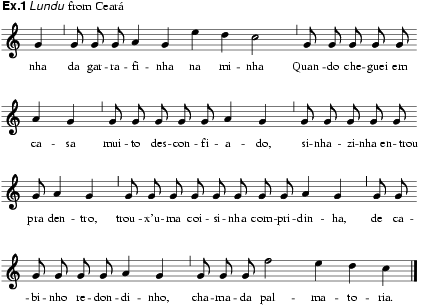
(Port. República Federativa do Brasil).
Country in South America. It is bordered by all other South American countries except Chile and Ecuador, and by the Atlantic Ocean to the east. It was colonized by Portugal after 1500, but the culture of the indigenous peoples survived. São Paulo, the largest centre of production in Latin America, is its financial capital, and Rio de Janeiro its cultural capital. The official language is Portuguese.
GERARD BÉHAGUE
Relatively little is known about art music activities and composition during the first two centuries of Brazilian history. The substantial documentation attesting to important musical activities in Pernambuco (Olinda, Recife) and Salvador, Bahia, was not compiled and studied until the mid-20th century. Throughout the colonial period most music-making related directly to church services, and surviving colonial music is therefore mainly sacred. The regular clergy was responsible for first organizing Christian religious life in Brazil. The Franciscans started using music in the conversion of the Amerindians, but it was the Jesuits who had the strongest influence on the musical life of the colony, and as early as 1550 the Jesuit Nóbrega had initiated musical instruction at Bahia. Instrument making did not flourish, however, until the 18th century. Organs and other instruments were built in Pernambuco and Minas Gerais.
The first extant colonial composition, a recitative and aria in the vernacular for soprano, first and second violins and continuo, was written at Bahia in 1759, but the attribution of the authorship to Caetano de Mello Jesus, mestre de capela at Bahia Cathedral, appears unfounded. Another early work is a Te Deum (c1760) for mixed chorus and continuo by Luiz Álvares Pinto, a mulatto composer who was mestre de capela at S Pedro dos Clérigos, Recife, and founder in that city of the important Irmandade de S Cecília dos Músicos, a musicians’ guild. In addition, he wrote a theoretical treatise, Arte de solfejar, whose manuscript is in the Biblioteca Nacional, Lisbon.
An exceptional musical life developed during the latter part of the 18th century in Minas Gerais province, in response to the socio-economic boom there. According to the musicologist F.C. Lange, who first uncovered the primary sources of that repertory, there were about 1000 musicians active in Minas Gerais between about 1760 and 1800, particularly in the cities of Vila Rica (now Ouro Preto), Sabará, Mariana, Arraial do Tejuco (now Diamantina) and São João del Rei. Most of them were mulatto and associated with various local brotherhoods (irmandades), musical guilds that were relatively independent of the clergy. Composers whose works are known include Lobo de Mesquita, Coelho Neto, Gomes da Rocha and Parreiras Neves. They all cultivated a prevailingly homophonic style in sacred works for mixed chorus with orchestral accompaniment including violins, viola, horns, occasionally oboes and flutes and continuo. Most of the compositions that have been discovered are liturgical (masses, motets, antiphons, novenas etc.). The only work with a vernacular text is Parreiras Neves’s Oratoria ao Menino Deos para a Noite de Natal (1789), discovered in Mariana in 1967; only its soprano and instrumental bass parts have survived. It is remarkable that this tradition of colonial church music has survived continuously in the city of São João del Rei, with the Orquestra Ribeiro Bastos and the Lira Sanjoanese, thanks to the efforts in the late 20th century of musicologist-conductor José Maria Neves and others. These organizations involve local amateur musicians as vocalists and instrumentalists.
The Bahian Damião Barbosa de Araújo (1778–1856) was an active composer of sacred music and left about 23 works. Of the various mestres de capela at São Paulo Cathedral, André da Silva Gomes was particularly notable, not only as a prolific composer of sacred music but also as an influential teacher. In the interior of the state of São Paulo, the town of Mogi das Cruzes was also a centre of sacred music; the manuscripts of 11 compositions, almost certainly dating from the late 17th and early 18th centuries, were discovered in 1984.
In the early 18th century the musical comedies of Antonio José da Silva (1705–39), nicknamed ‘O Judeu’, enjoyed great success in the colony as well as in Lisbon. Musical life at Rio de Janeiro was greatly stimulated by the transfer to that city of the Portuguese royal court in 1808. In the same year King João VI created the royal chapel to which he appointed as musical director and mestre de capela the mulatto composer Nunes García, who is rightly considered one of Brazil’s finest musicians. 237 of his works are extant, among them a multitude of masses, motets, and pieces for Holy Week and other feast days. His earlier sacred pieces have a devotional character while his later ones, like those of contemporary Europe, show the influence of opera in both choral sections and arias. His Requiem (1816), written on the death of Queen Maria I, and Missa de Santa Cecília (1826) are generally considered his masterpieces.
Professional European composers began to migrate to Brazil during João VI’s residency in Rio de Janeiro. Most notably, the Portuguese opera composer Marcos Portugal settled there in 1811, adding great prestige to the musical life of the city. The Austrian Sigismund Neukomm was employed by the court from 1816 to 1821 to teach the young Prince Pedro; he wrote the Missa para o dia da Aclamação de João VI and earliest known Brazilian piano piece (1819), using a tune from a Brazilian popular song.
The 19th-century musical scene was dominated by opera and salon music. After independence the former Royal Theatre became the Imperial Theatre. The reign of Pedro II was characterized by the cultivation and official protection of Italian opera; Bellini’s Norma in particular was often performed. In the government-subsidized theatres in Rio (e.g. S Pedro de Alcântara, and later Provisório) the principal operas of Rossini, Verdi and their contemporaries were produced. Manuel da Silva, remembered today as the composer of the Brazilian national anthem, attempted to stimulate the use of the vernacular in the operatic repertory. In 1847, under the auspices of the emperor, an institution was created with that aim, the Imperial Academy of Music and National Opera. After that date the first native operas were presented; their composers included Álvares Lôbo, Alves de Mesquita and, above all, Carlos Gomes who had the most brilliant career of any composer of the southern hemisphere in the 19th century. He studied at Milan Conservatory, and with the première of Il Guarany at La Scala in 1870 reached the climax of his career.
Regular concert life developed particularly in Rio de Janeiro, but only during the last three decades of the 19th century. Concert societies and clubs were founded which promoted the appearance in Brazil of some of the most celebrated performers of the time (Thalberg, Napoleão, Gottschalk). Concurrently several composers, such as Miguéz and Oswald, cultivated the prevailing European styles, particularly those of Wagner and the early Impressionists. Francisco Braga, an influential teacher of composition, fostered a local adaptation of Wagnerian Romanticism.
The first ‘nationalist’ composition was published in 1869 by Itiberê da Cunha, an amateur musician and an accomplished pianist. His piano piece A Sertaneja attempts to recreate in various ways the atmosphere of urban popular music, and quotes a characteristic popular tune. Alexandre Levy wrote his most typically national compositions in 1890, among them the Tango brasileiro for piano, and the Suite brésilienne for orchestra, the first of many such pieces produced by later nationalist composers. The last movement, ‘Samba’, can be considered the first decisive step towards musical nationalism; it draws on urban popular dance rhythms, such as those of the maxixe and the Brazilian tango, rather than on the characteristics of the folk samba.
By the beginning of the 20th century art music in Brazil began to display definite individuality. The composer Alberto Nepomuceno played a primary role in the creation of genuine national music: many of his compositions present folk or popular material or simply draw directly on popular music. The last movement (‘Batuque’) of his Série brasileira (1892) for orchestra is symptomatic of the discovery of the rhythmic basis of popular music, and anticipates similar accomplishments in 20th-century compositions.
After about 1920 the most important figure of Brazilian art music was Villa-Lobos. He wrote about 1000 works (including arrangements) in a wide variety of genres and media. The Week of Modern Art in São Paulo, in 1922, led by Mario de Andrade and others, was a great stimulus to Villa-Lobos’s exploration of musical nationalism. Among his most important works of the 1920s the nonet Impressão rápida de todo o Brasil, the series of Choros, inspired by urban popular music of the early years of the century, and piano works, such as Rudepoema, Prole do bebê nos.2 and 3 and Cirandas, reveal the various facets of his creativity. His final productive period (1930–57) includes the nine Bachianas brasileiras, 13 string quartets out of a total of 17, seven symphonies out of a total of 12, numerous solo songs etc. The Bachianas were intended as homage to J.S. Bach, and were written as dance suites beginning generally with a prelude and ending with a fugal or toccata-like movement. Actual Baroque compositional techniques are seldom used; the use of the fugue as a formal principle is a neo-Baroque device, resulting in clear horizontal movement and systematic imitation. Other neo-classical devices – ostinato figures and long pedal notes – are also used.
Of Villa-Lobos’s contemporaries Oscar Lorenzo Fernândez, Luciano Gallet and Francisco Mignone were typical of the orientation towards native styles. Mignone, a pianist, flautist and conductor, cultivated a national style relying heavily on urban popular and folk idioms, as in his four Fantasias brasileiras for piano and orchestra and in the series of piano pieces Lendas sertanejas, Valsas de Esquina and Valsas-choros.
The most important composers of the next generation included Camargo Guarnieri, Luiz Cosme, Radamés Gnatalli and José Siqueira. Guarnieri, a prolific composer, achieved an international reputation. Cosme’s works include the ballet Salamanca do Jaráu (1933), and Novena à Senhora da Graça (1950), written in a free 12-note technique. Gnatalli cultivated both popular and art music, with an inclination in his later works towards neo-classical idioms.
The younger composers first active in the 1940s (e.g. Claudio Santoro and César Guerra Peixe) alternated between musical nationalism and prevalent European techniques, particularly Schoenberg’s dodecaphonic theories, first introduced in Brazil by the German composer Hans-Joachim Koellreutter. Edino Krieger, after incursions into strict atonality, found some interesting compromises within a modern neo-classical style (e.g. in his First String Quartet, 1956). Serial and experimental techniques have been used by younger composers who became known during the 1960s, when São Paulo became the centre of the Brazilian avant garde; the Música Nova group there included Gilberto Mendes, Damiano Cozzella, Willy Corrêa de Oliveira and Rogério Duprat. The subsequent focus of new music, the Bahia Group of composers, founded in 1966, included Ernst Widmer, Jamary Oliveira, Lindembergue Cardoso, Fernando Cerqueira, Walter Smetak and Milton Gomes, all wholly committed to the contemporary artistic world. Under the leadership of Widmer, the Bahia Group remained quite distinctive in the eclecticism of its members, who stressed individuality rather than fashionable trends. In spite of the limited means of the Brazilian musical scene, by the 1970s most composers advocated the use of new musical resources and techniques, thus breaking completely with the predominant trend of musical nationalism. For example, Mendes’s Nascemorre is a setting for voices (using microtones), percussion and tape of a text by the concrete poet Haroldo de Campos. The major figures who emerged in the 1970s and 80s included Marlos Nobre, Jorge Antunes, Almeida Prado, Aylton Escobar, Ricardo Tacuchian, Jocy de Oliveira, Raul do Valle, Ronaldo Miranda and Vasconcellos Corrêa. During the period 1975–97, the Bienal de Música Brasileira Contemporânea, organized in Rio mainly by Edino Krieger, represented a much-needed encouragement for Brazilian composers, while the Sociedade Brasileira de Música Contemporânea, especially during the tenure of the pianist Belkiss Carneiro de Mendonça, was influential in creating a sense of community. By the 1980s studios for electro-acoustic composition had been established in major universities in São Paulo, Rio de Janeiro, Belo Horizonte, Brasília and Bahia. In the 1990s the most promising Brazilian composers included Paulo Costa Lima, Agnaldo Ribeiro, Luis Carlos Csekö, Marisa Rezende, Tim Rescala, Flo Menezes, Cirlei de Hollanda, Rodolfo Coelho de Souza, José Augusto Mannis, Vânia Dantas Leite, Rodrigo Cicchelli Velloso and Roberto Victorio.
See also Minas Gerais; Pernambuco; Rio de Janeiro; Salvador; São Paulo.
G. de Melo: A música no Brasil desde os tempos coloniais até o primeiro decênio da República (Bahlia, 1908, 2/1947)
R. Almeida: História da música brasileira (Rio de Janeiro, 1926, enlarged 1942)
V. Cernicchiaro: Storia della música nel Brasile, dai tempi coloniale sino ai nostri giorni (1549–1925) (Milan, 1926)
M. de Andrade: Ensaio sôbre a música brasileira (São Paulo, 1928)
M. de Andrade: Pequena história da música (São Paulo, 1929, 8/1977)
M. de Andrade: Música, doce música (São Paulo, 1934)
L.H. Corrêa de Azevedo: Relação das óperas de autores brasileiros (Rio de Janeiro, 1938)
M. de Andrade: Música do Brasil (Curitiba, 1941)
N. Slonimsky: Music of Latin America (New York, 1945, 3/1949/R1972 with new foreword and addenda)
R. Almeida: Compêndio de história da música brasileira (Rio de Janeiro, 1948, 2/1958)
V. Mariz: Dicionário bio-bibliográfico musical (brasileiro e internacional) (Rio de Janeiro, 1948, enlarged 2/1985 as Dicionário biográfico musical: compositores, intérpretes e musicólogos, 3/1991)
V. Mariz: Figuras da música brasileira contemporânea (Oporto, 1948, enlarged 2/1970)
L.H. Corrêa de Azevedo: Música e músicos do Brasil (Rio de Janeiro, 1950)
M. de Sampayo Ribeiro: A música no Brasil (Lisbon, 1950)
L.H. Corrêa de Azevedo, C. Person de Matos and M. de Moura Reis: Bibliografia musical brasileira (1820–1950) (Rio de Janeiro, 1952)
L.H. Corrêa de Azevedo: 150 anos de música no Brasil (1800–1950) (Rio de Janeiro, 1956)
F.C. Lange: A organização musical durante o período colonial brasileiro (Coimbra, 1966)
R. Stevenson: ‘Some Portuguese Sources for Early Brazilian Music History’, YIAMR, iv (1968), 1–43
G. Béhague: The Beginnings of Musical Nationalism in Brazil (Detroit, 1971)
B. Kiefer: História da música no Brasil (Porto Alegre, 1976)
M. Marcondes, ed.: Enciclopédia da música brasileira, erudita: folclórica, popular (São Paulo, 1977, 2/1998)
G. Béhague: Music in Latin America: an Introduction (Englewood Cliffs, NJ, 1979)
V. Mariz: História da música no Brasil (Rio de Janeiro, 1981, 4/1994)
J.M. Neves: Música brasileira contemporânea (São Paulo, 1981)
3. Luso-Brazilian folk music traditions.
4. Afro-Brazilian folk music traditions.
Brazil, §II: Traditional music
(ii) Cultural and musical areas.
(iii) General musical characteristics.
Brazil, §II, 1: Traditional music: Introduction
The folk and traditional music of Brazil has been studied from various angles since the beginning of the 20th century; however, although the collecting of substantial folk and popular music repertories has improved during the last four decades of the 20th century, it remains limited. The samples collected are relatively recent and have not undergone adequate analytical examination. Historical studies of folk or popular musical genres do not, for the most part, rely on sound documentary evidence. With few exceptions, historical archives in both Brazil and Portugal have not been sufficiently scrutinized to enable us to reconstruct the history of folk music in Brazil. Such archival documents include, most importantly, travellers' chronicles describing songs and dances, and valuable ethnographic data. Several Brazilian writers have pointed out the almost total absence of notated examples in Brazil or Portugal of folk and popular music during the colonial period (16th century to early 19th). Our knowledge of this music is therefore necessarily limited to certain song and dance genres and the various socio-cultural contexts in which they function. Collected examples of such genres date only from the late 19th century. Substantial field collections of folk music were first made in the 1930s. The study of continuity and change in Brazilian folk and popular traditions can therefore be contemplated only for a fairly recent past in well-determined areas.
As with most Latin American countries, it is difficult to make a clear distinction between Brazilian popular music and folk music. Until the 1930s, with a few exceptions, clear distinctions between rural and urban areas could hardly be made in Brazil, since the culture of most cities and towns was strongly rural-orientated. The continuous growth of urban centres since the 1940s, however, makes the distinction easier as a large urban market for popular musical genres has developed. Concurrently the migratory movement from the rural areas has activated a substantial amount of folk music-making and consumption in the cities. Mass media and the greater mobility of the rural population have had inevitable consequences on certain repertories and folk music genres, especially choreographic genres used in a social secular context. Such important changes have, however, hitherto received minimal attention.
Brazilian folk music reflects its varied cultural origins. Since the country was colonized by the Portuguese, Luso-Hispanic folk music constitutes the basis of Brazilian folk music. Portuguese material has, in most cases, undergone essential modifications throughout Brazilian history but certain stylistic characteristics, such as Iberian folk polyphony, have been retained. Portuguese melodies, especially in children's songs, can still be found. Melodies built on the older European modes, ‘gapped’ scales and altered modes can easily be related to Portugal. The harmonic system prevailing in most folk and popular genres is likewise a European heritage. The rich variety of Luso-Hispanic instruments, particularly string instruments, has also penetrated the country.
The slave trade with Africa lasted for almost four centuries. While at first most of the Africans originated from Angola and the Congo area, Yoruba and Fon-Dahomeans predominated during approximately the last 150 years of the slave trade. Yet most Afro-Brazilian songs and dances show a clear Bantu origin, with the exception of certain cycles of songs functioning in some Afro-Brazilian religions. Specific scales frequent in Brazilian folk music have been attributed to an African origin: pentatonic scales, major diatonic with a flattened seventh and major hexatonic without the seventh degree. African rhythmic traits, such as the hemiola rhythm, form the basis of many rhythmic intricacies of Brazilian folk music. While not as sophisticated as its African counterpart, drum music among Afro-Brazilians exhibits similar complexity. Specific instruments have been inherited from the Africans, as well as certain performance features, such as responsorial singing and vocal style.
The third major ethnic group that contributed to the early formation of Brazilian folk music is the Amerindian group. Tropical Indian cultures in Brazil are by no means homogeneous, and knowledge of tribal music is restricted to a few scattered enclaves. Vestiges of this music in the main folk traditions of Brazil can at best be revealed through the retention of certain types of instruments, mainly rattles of the maraca type, certain choreographic genres and performance characteristics.
It is clear, however, that the most substantial contribution to the origin and development of Brazilian music comes from Portugal. The predominance of white people and their influence on Amerindians and Afro-Brazilians and the reverse acculturative process have created an essentially mestizo culture, the components of which are the result of that amalgamation. Thus genuine Brazilian folk musical traditions are mestizo traditions.
Brazil, §II, 1: Traditional music: Introduction
Although Brazilian folk music cannot be considered homogeneous because of its varying socio-cultural patterns, there is a large enough corpus of music in the various geographical areas for the general characteristics to be described. There have been several attempts to define cultural areas in Brazil, but the criteria of classification have neglected musical traits. Maynard de Araújo (1964), for example, has proposed the following division: Amazon area, cattle herding area, mining area, agricultural area, fishing area, with subdivisions, all according to techniques of subsistence. Joaquim Ribeiro was the first to propose, in 1944, a set of four musical areas, based on musical genres: embolada (north-east); moda (south); jongo (several zones of Bantu influence); aboios (cattle herding zone of the hinterland or sertão). Azevedo (Grove's Dictionary, 1954) based his own more comprehensive classification on the distribution of musical genres and instruments. He distinguished nine musical areas and one song cycle: Amazon area; cantoria area (north-east); côco area (north-eastern coastal area); area of the autos (throughout the country, with specific nuclei in Sergipe and Alagoas); samba area (from the states of Bahia to São Paulo); moda-de-viola area (from Goiás, Mato Grosso to northern Paraná); fandango area (southern coastal area); gaúcho area (cattle zone of Rio Grande do Sul); modinha area (including mostly the oldest urban areas); and the cycle of children's songs found in all areas (fig.1). This classification is useful as a main working tool, but omits Brazilian indigenous music as a result of the extremely limited attention that this has received. In addition, it has had to disregard the numerous overlappings of distribution of folk genres.
Brazil, §II, 1: Traditional music: Introduction
Cultural syncretism of various kinds (Amerindian with Portuguese, Amerindian with Spanish, Amerindian with African, Portuguese with African, Spanish with African, and the fusion of syncretism among all of these with native black Brazilian) has created a substantial diversity of folksongs and dances. Within that diversity, certain stylistic elements unify the various repertories.
Melodic organization tends to follow patterns associated with Europe, such as arched melodies, conjunct motion and melodic gravity. Antecedent and consequent strains occur frequently in Brazilian folksongs. Short and symmetrical phrasing is also generally observed. Melodic tension created by intervallic leaps tends to occur at the beginning of a song, followed by a typically conjunct descending motion, or a static phrase made up of repeated notes. This markedly descending tendency has been attributed to western European and West African influences in Brazilian music. But a similar characteristic has been shown to exist also in the music of the Nambicuara Indians of Mato Grosso, among other Amerindian groups. Very frequently the descending motion follows an undulating design. Melodic sequence abounds. Songs more closely associated with Iberian folk traditions exhibit a predominantly triple metre (3/4) or compound metres (6/8, 9/8). Duple metre prevails in genres of a clearer Afro-Brazilian folk origin, though quite often there is a duple-triple composite in actual performance, creating the hemiola rhythmic effect.
A large proportion of cadences end on the dominant or the mediant and masculine endings predominate, as the result of Portuguese prosody. In addition, there is a great deal of recitative-like singing, with little or no metric structure, and with some ornamentation. Plainsong has been considered an important influence on Brazilian folk melodic characteristics. From the 16th century onwards missionary work carried the well-established Iberian tradition of singing Gregorian melodies. Furthermore some aspects of Portuguese folk music implanted in Brazil already had Gregorian chant characteristics in melody, modes and rhythms. Mário de Andrade was the first to call attention to rhythmic traits and melodic cadences related to chant. Later, Oneyda Alvarenga (1950), Tavares de Lima (1954) and Father José Geraldo de Souza (1960–63) provided examples from various areas. Ex.1, a lundu melody collected in Ceará, illustrates Gregorian characteristics, such as beginning on the dominant and ending on the tonic; cadential diatonicism; and the seventh or G mode. Examples of true recitatives and types of cantillation occur frequently. The amensural nature of ex.2 is typical. Besides this rhythmic freedom in melodic phrasing, melodies and cadences are frequently based on the church modes, such as the A mode shown in ex.3, a reisado from Rio Grande do Norte; the D mode in ex.4, a lullaby from Pará; the F mode in ex.5, a mendicant blind man's cry from the north-east; and the E mode in ex.6 in a pagelança song from Pará.

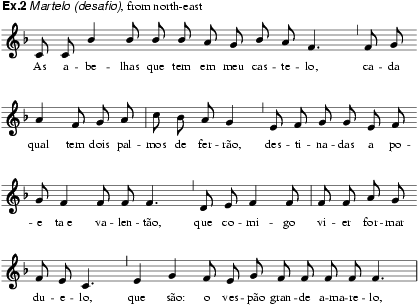
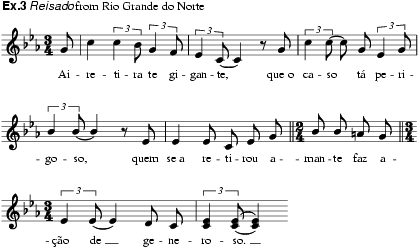
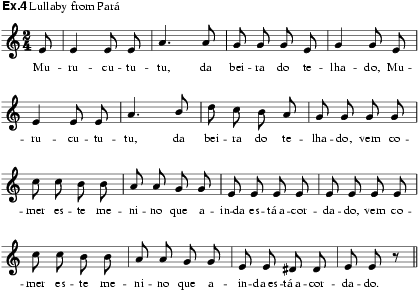
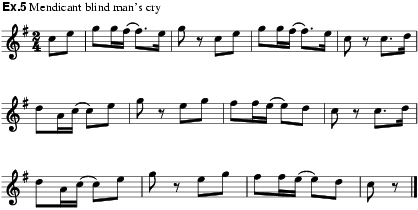
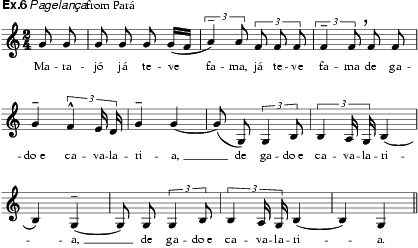
Despite these instances of modes, melodies tend to be mainly diatonic and tonal (or major/minor). Anhemitonic pentatonic scales prevail in certain repertories. The range in Brazilian folk music varies a great deal: generally, songs have a narrower range than strictly instrumental pieces; while many songs exceed the octave in their range, most do not.
The melodic material is organized in several forms, predominantly stanza-refrain alternation and strophic form with slight variations. Through-composed songs occur to a much lesser extent. Literary forms inherited from Spain and Portugal, such as quatrains and décimas (ten-line verse), common in the romances, or ballads, have naturally determined their musical forms. In songs and dances of a more specifically Afro-Brazilian stock, the stanza-refrain pattern often shows textual and musical improvisation in the stanza (performed by a soloist) with a set choral refrain.
Of all the musical elements rhythm is certainly the most difficult to generalize about. In theory, the Iberian heritage has provided Brazilian folk music with triple and compound metric structures (3/4, 6/8, 9/8), and the clear stressing of downbeats. Simple isometric figures abound. Dotted figures (ex.7a) or compound triple time (ex.7f) are quite common. The peculiar rhythmic characteristic of Brazilian music, however, is syncopation, either by irregular accentuation or anticipation. Syncopations are generally contrasted with a steady rhythmic pulsation (often represented as semiquaver units). Exx.7a–f give some indication of the frequent rhythmic patterns occurring in mestizo folk music. Numerous variant possibilities, however, are present in performance. The rhythmic practices most commonly associated with Afro-Brazilian folk music reveal a subtle duple-triple ambivalence, as illustrated in exx.7i and 7j, which show two different renderings of rhythmic patterns. The characteristically African hemiola rhythm is often found. Irregular rhythmic structures and amensural or free-rhythm melodies occur in certain song types, such as the typical aboios (cattle herding songs) of the north-eastern states.

Polyphonic parallelism prevails. The most common type of folk polyphony inherited from the Iberian peninsula involves singing in parallel 3rds and 6ths, either by two or more soloists or more commonly in responsorial singing. This type of polyphonic practice is also present in instrumental music. Parallel 4ths and 5ths, although rare, are found more readily in songs of a soloistic nature. Singing and playing at the octave are relatively common. Imitative types of polyphony are rare and are not systematized. Song types such as the desafio and embolada, which involve alternate singing, are not polyphonic. Overlapping commonly occurs with responsorial singing. Contrapuntal textures abound in certain instrumental types of urban popular music, such as the choro.
Brazil, §II, 1: Traditional music: Introduction
Indigenous, African and European instruments are played in Brazil, although it is not always possible to determine the origin of each with accuracy.
It is generally accepted that Amerindians did not have chordophones at the time of the conquest. In Brazil the rare examples described in the literature are post-colonial or even 20th-century. The musical bow, called urucungo in the south and berimbau (or berimbau de barriga) in the north and north-east, with or without resonator, is much in use in such dance-games as the Bahian capoeira. Of African provenance, the berimbau is still played in an African manner: the string is struck with a wooden stick and a metal coin serves as a bridge. Timbre may be changed by manipulating the resonator against or away from the body of the performer. Generally a small basket rattle, called caxixi in Bahia, accompanies the strokes of the stick, as shown in fig.2.
The majority of string instruments came from Europe, particularly from the Iberian peninsula. Most important in the various folk musical expressions of Brazil is the viola, a type of guitar with five double courses made of wire or steel. There are various sizes, the standard one being somewhat smaller than the Spanish classical guitar. There are at least five types of viola distributed throughout the country: the viola paulista, cuiabana, angrense, goiana and nordestina. The differences are mostly in size, in number and material of strings, and in tunings. The variety of tunings is considerable. In São Paulo alone some 25 tunings are known, such tunings being used according to the particular function of the instrument. To accompany the song genre known as moda, for example, the tuning A–D–G–B–E, known as quatro pontos, is considered most suitable. Viola players give each tuning a special name. Thus, in São Paulo and southern Brazil in general, D–G–B–D–G is termed cebolão, E–B–E–G#–B cebolinha simples, D–G–B–E–A cana-verde or cururu, D–G–C–F–A# oitavado or pontiado-do-Paraná. The instrument may be used to accompany both singing and dancing, but it is also played solo and frequently in duets. Myths and legends involving the viola attest to its paramount importance among the Brazilian people. The personalization of the instrument has created certain magic secular rituals designed to prevent ‘diseases’ affecting the viola. A special type of viola is the viola de cocho, known as the ‘Brazilian lute’, with five single strings, a short neck and no soundhole. It is used in Mato Grosso in the cururu festivities.
In conjunction with the viola, the Portuguese rabeca, or fiddle, tuned A–D–D–G, is still used in popular religious feasts, dramatic and secular dances. In the 1920s it began to decline in popularity, only to regain some of its former importance in the 1980s. The Spanish guitar is also widely played in Brazil, particularly in the urban areas. The cavaquinho is of Portuguese origin and has gained a wide popularity in the cities since the late 19th century. It has four metallic strings tuned d'–g'–b'–d''. The machete is similar to the cavaquinho and possibly comes from Madeira Island. Other chordophones in Brazilian folk music are the mandolin (Port. bandolim) and the banjo, the latter introduced in the 1930s.
The majority of the many types of idiophone are of Amerindian and African derivation. The maraca and the various types of chocalhos are the most widespread of the shaken rattles. The pre-Columbian Amerindian maraca (mbaracá) is made of a calabash filled with dry seeds. Chocalho has become the generic term for shaken and struck rattles made of different materials and varying in shape and size (fig.3). They are often known by their onomatopoeic names, such as xaque-xaque, xeque-xeque, xequerê, xexerê etc. The ganzá (or canzá) often appears as a two-headed chocalho, usually made of metal. Though generally considered to be of African origin, because the Amerindians had no metal idiophones when the first African slaves were brought to Brazil, it is strikingly similar to the maraca and, as with other rattles, there is not enough evidence for one to be certain of its origin. The afoxê (or afuxê), called xequerê in Bahia and more generally piano-de-cuia, is another widespread type of rattle. Instead of the calabash being filled with seeds, it is covered with threaded beads or cowrie shells, as in West Africa. The instrument is played by rotating the calabash from the handle with the right hand while the beads are held firmly with the left hand. Basket rattles are known among both Amerindians and Afro-Brazilians. The caxixi, mentioned above in connection with capoeira, has its counterpart in the angóia of the jongo and batuque dances. The most widespread struck idiophone is the agogô, a cowbell of African provenance. Usually a double bell, it is struck with a metal rod and used on different occasions. The single-bell instrument called gan is preferred among the more traditional Afro-Brazilian religious groups. In the same groups the adjá, similar to the agogô, fulfils a more specifically liturgical function. The African marimba (xylophone) has lost its former importance as a solo instrument or an accompanying instrument for singing. In modern times it is used only to accompany such dramatic dances as the congada. The two types of marimba still in use are portable and have six and 11 keys respectively, which are struck with wooden sticks. The African lamellophone is practically extinct in Brazil.
A popular type of scraped idiophone is the reco-reco (also known as raspador, casaca or catacá; fig.4); it is used in traditional rural dances such as the congada, cururu, cana-verde and folk samba, as well as in modern urban dances such as Carnival sambas and marches. Numerous types of membranophone of European and African origin are used in Brazilian folk and popular music. The conical single-headed drum, similar to the Afro-Cuban conga drum, is known throughout the country under the generic terms atabaque and tambor. Of African derivation are the various drums accompanying Afro-Brazilian religious ceremonies. There the atabaques are generally played in threes, each of different size, and are known in Bahia, from the largest to the smallest, as rum, rumpí and lê (fig.5). These drums are played with sticks, with hand and stick or with the hands alone, depending on the particular religious group or particular song repertory. In the north-eastern provinces, especially Pernambuco and Ceará, cylindrical single-headed drums are known by the Yoruba name of ilu, although the same term was formerly used for double-headed barrel-shaped drums. Tambu designates a similar cylindrical single-headed drum, especially in the southern-central and southern regions where it plays an important role in the jongo and the batuque dances. The candongueiro or candongueira is a small tambu used in the jongo and usually played with the fingers only. A still smaller and higher-pitched drum in the jongo is the cadete. Another African drum still used in the batuque is the mulemba or quinjengue which has a funnel-like shape, giving it a higher pitch. The skin of all these drums is traditionally attached to the body either by pegs or by wedges, but modern mass-produced conga-type drums use screw devices. The ‘talking drums’ of West Africa with their typically varying pitch are unknown in modern Brazil.
A characteristic drum known throughout the country is the cuíca or puíta, a friction drum with remarkable pitch range. Its origin is difficult to determine. Introduced in Brazil probably by Bantu slaves, it has also been known in Spain for centuries and it is believed to have been brought to Africa by Muslims. It is used in numerous folk and urban popular dances. The tambourine is known in Brazil with and without jingles. The oldest type is the adufe, a square tambourine, usually without jingles, of Arab origin, but brought to Brazil by the Portuguese and still much in use in Portugal. The standard tambourine is known as pandeiro and since the early 20th century has become one of the most widely accepted drums in popular music. The instrument known in Portuguese as tamborim is a small (30 cm long and 15 to 18 cm in diameter) cylindrical drum percussed with a stick, used in dramatic dances such as the congada and moçambique and in the percussion ensembles of Carnival bands.
Double-headed drums of European origin include snare drums (known as caixa) of various sizes (the smaller is often referred to as tarol, the larger as caixa-surda or surdo). The zabumba, variously called bombo, bumba and tambor grande, is a bass drum played with a beater, popular in the north-eastern states where it leads ensembles consisting of two or three fifes, as in the Beira province of Portugal. The zabumba accompanies rural sambas, congadas and other dances. Double-headed drums are the most common types among Brazilian Indians.
Amerindian tribes have a wide variety of flutes, trumpets and whistles. The flutes include transverse flutes made of reed, slit tubes, nose flutes, and reed panpipes such as the aviraré of the Aweti Kamaiurá of the High Xingu area (fig.6). Aerophones in Brazilian folk and popular music are mostly modern European instruments, from simple fifes to valve trumpets, trombones and saxophones. The modern flute and the piccolo have been cultivated in urban popular music since the advent of the urban samba in the second decade of the century. Both button and piano keyboard accordions (sanfona) are widely used in folk and popular music throughout the country. In folk music wind instruments generally play a lesser role than percussion and string instruments.
Brazil, §II: Traditional music
Brazilian
Indians belong to the tropical forest type of indigenous culture. This has been
classified according to the relative degree of integration with the main
national (i.e. Luso-Brazilian and mestizo) socio-cultural groups. Most Indians,
however, have had sporadic or no contact with white and mestizo Brazilians. In
such cases they maintain cultural autonomy. Those who have had permanent
contacts have been, or are in the process of being, integrated into the
mainstream of Brazilian society. Four main indigenous linguistic families have
traditionally been distinguished: Tupi, Arawak (Aruak), Carib and Gê, with
several subdivisions. 11 indigenous culture areas have been proposed by Darcy
Ribeiro and others (fig.7). The music of the Taulipang
Indians from the northern Amazon area (between Rio Negro and the coast) was
collected by Theodor Koch-Grünberg from 1911 to 1913 and subsequently studied
by Hornbostel, who outlined the following traits: existence of solo and choral
singing; melodies of medium range, generally less than an octave (ex.8 has a range of a minor 7th);
conjunct and descending melodic motion; predominantly ternary divisions of
fixed rhythmic patterns. Dance music seems to prevail in the collected
repertory, but curing songs and other songs for ritual ceremonies, such as
hunting magic, are also common among the Taulipang. Hornbostel observed that
the motivic organization of most Taulipang songs is simple and that the motifs
are frequently interrelated. Ex.8 provides a good illustration of the
strophe arrangement. According to Hornbostel they ‘fall into two halves of
three motives each a b d/e f c: the 4/2 groups of the first part become the 3/2
in the second, and the final tactus through omission of the pause is further shortened
to 5/4. The motive g–f![]() –e
is expanded to 4/2 cadence, and is repeated in b as 2/2 and in d
as 1/4. (Such progressive abridgements are generally characteristic of the form
of the Indian style.)’ Music from the Jeruá-Purus area, south-west of the
Amazon River, has not yet been collected and studied.
–e
is expanded to 4/2 cadence, and is repeated in b as 2/2 and in d
as 1/4. (Such progressive abridgements are generally characteristic of the form
of the Indian style.)’ Music from the Jeruá-Purus area, south-west of the
Amazon River, has not yet been collected and studied.
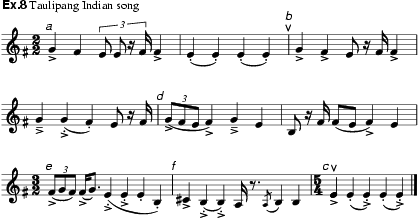
The music of the Nambicuara Indians of the Guaporé area was first collected and studied by Roquette Pinto. He observed among them war and festive dances, and two types of flute: the nose flute with three holes (studied by Izikowitz and Halmos; fig.8) and the double flute. Ex.9, collected by Roquette Pinto in 1912, shows a clear tonal centre (e'), conjunct motion, and the narrow range of a minor 3rd. Isometric rhythmic structure is also evident. Material collected by Lajos Boglár in 1959 and studied by Halmos shows that the neighbouring Paressí Indians sing melodies similar to those of Nambicuara. Halmos was able to characterize Nambicuara melody as having a small range and frequently repeated motifs. But melodic structures do not always appear to be simple. They consist in general of stanzas, ‘the totality of which form the melody’. The number of stanzas in sung melodies is constant while ‘there is no regularity in the length of the melodies performed on instruments’. The 28 melodies analysed reveal a descending motion, a medium average range (out of the 28 only four extend to a 7th), and the presence of a basic final on which the stanzas always end.
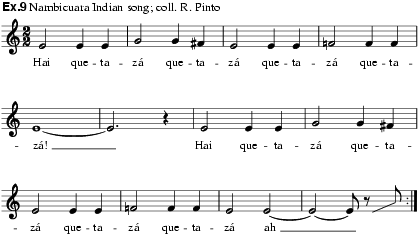
From the Tapajós-Madeira area, lying approximately between the two rivers, western Pará and eastern Amazonas, little of the music of the Mura-Pirahã Indians is known. The oldest example, collected and transcribed by Spix and Martius in the early 19th century, reveals the same general characteristics of Brazilian indigenous music: six-note scale with a tonal centre; melodic range of a minor 6th; prevailing conjunct motion; motifs related in an ABCD organization; and isometric rhythm (ex.10).
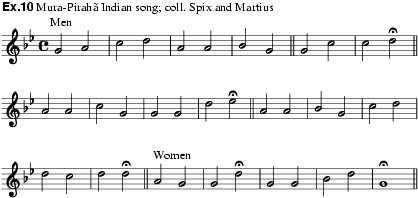
In
the High Xingu area in the state of Mato Grosso, between the rivers
Paranatinga, Ronuro and Culuene, the Parque Indígena do Xingu, a large
reservation, has brought together numerous tribes. Traditionally, the principal
groups of this area are the Kamaiurá (Tupi), the Mehinaku and Yawalapiti
(Arawak) and the Trumai. Kamaiurá music has been studied by Menezes Bastos.
Kamaiurá Indians have giant flutes (up to 2·5 metres in tube length) known as uruá,
with ritual functions. The aviraré (four- or five-tube panpipes, up to
50 cm in tube length; fig.6) are used as an introduction
to the mastering of the uruá, but while they can be played by one person
only, the uruá requires two players (fig.9). Ex.11 illustrates Kamaiurá vocal
dance music. A characteristic feature is the microtonal sliding of the voice
followed by a wide-range descending glissando. The isometric rhythmic figures
emphasize the beginning of each phrase, stressing the long note values. The
noticeable exhaling and harsh aspiration corresponding to this beginning of
phrases was pointed out by Hornbostel as a typical feature of Amerindian vocal
style. In addition, there is a direct relationship between tension and pitch, d![]() being the tension point.
As indicated in the studies of Menezes Bastos (1978, 1986, 1988), Kamaiurá
music functions as a form of knowledge and communication in very specific ways.
An elaborate system of taxonomy reveals the presence of an ethnotheory that
explains the cognitive processes differentiating and integrating music, speech
and language, and the various levels of music-making in which musical
instruments and human voices take on particular meanings. Such a theory,
elucidated primarily through linguistic analyses, also clarifies the close
connections between such concepts as musical substance and elaboration and the
culture's political, economic and basic social structures.
being the tension point.
As indicated in the studies of Menezes Bastos (1978, 1986, 1988), Kamaiurá
music functions as a form of knowledge and communication in very specific ways.
An elaborate system of taxonomy reveals the presence of an ethnotheory that
explains the cognitive processes differentiating and integrating music, speech
and language, and the various levels of music-making in which musical
instruments and human voices take on particular meanings. Such a theory,
elucidated primarily through linguistic analyses, also clarifies the close
connections between such concepts as musical substance and elaboration and the
culture's political, economic and basic social structures.
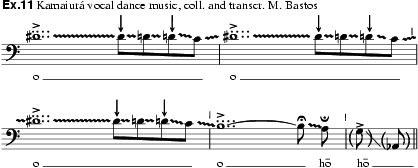
The music of the Suyá Indian community, also from the High Xingu, has been the subject of extensive study by Anthony Seeger (1987). Here also one finds specific native categories of forms of sound production. For example the Suyá term ngére refers to song (and by extension music, since they only know songs), sangére to invocation (curing songs), sarén to instruction or telling and kapérni to speech. There are significant relationships between these vocal forms: music and speech are not separated, rather they operate in a continuum determined by contexts. What seems to distinguish song from the other forms is first ‘the priority of melody over text, the fixed mode of its presentation, the extensive use of textual repetition, the fixed length of its phrases, the fixed relations among pitches, and the authority of its fixed texts’ (Seeger, 1987). There are, however, different genres of song. The akia (‘shout song’ or call) designates individual songs performed by adult men or boys ‘until they have several grandchildren’, while ngére (‘unison song’), distinct from akia, designates song usually performed in unison and in a lower register by men, women, boys or girls. The functions of these songs are numerous but their most significant aspects are associated with social relations and identity. Thus akia reaffirms social ties to sisters and mothers and expresses emotions. Ngére is used ‘to reaffirm the identity of the collectivity’ and the invocation would serve ‘to instill a particular animal trait into the body of the patient so that a desirable physical change could take place’. The integration of song performance within Suyá cosmology reveals the degree to which songs represent the very centrality of Suyá existential essence.
The Tocantins-Xingu area, between the two rivers, in south-eastern Pará and northern Goiás, is inhabited by Kayapó Indians, of whom the Gorotire are a sub-group belonging to the Gê linguistic family. They apparently know only three types of instrument: gourd rattle, stamping tubes and a small trumpet; the last is thought to be the result of outside influence. Much of the collected music reveals the predominance of choral monophonic pieces with pentatonic melodies.
The Pindaré-Gurupi area, between the two rivers, extends to the Guamá and Capim rivers in the west and to portions of the Grajaú and Mearim rivers in the east. The music of the Urubu-Kaapor Indians (of the Tupi family) from this area has been studied by Helsa Cameu. Although this music reveals tritonic to pentatonic scales, simple polyphonic singing occurs, perhaps the result of intermittent contact with mestizo culture.
In the Paraguay area, to the south of the swamp region of Mato Grosso, the Kadiweu Indians are an integrated group. The Kadiweu song shown in ex.12, collected in the late 1940s, is accompanied by the maraca. Its characteristics are: tetratonic scale (d–e–g–a), predominant arched melodic motion and isometric rhythm.
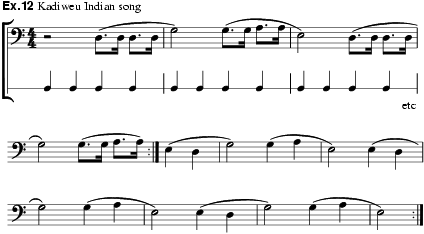
The Paraná area, on the border between Paraguay and Brazil, is inhabited by Guaraní Indians. The Kaiwa, for example, belong to this group and are now found in various areas of the states of Paraná and São Paulo. Their choral music exhibits parallel polyphony; ex.13 illustrates parallel 4ths. (For further discussion of Guaraní music see Paraguay.)
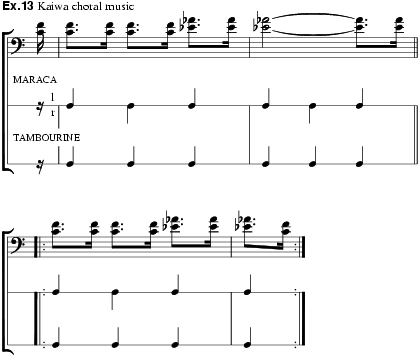
In the Tietê-Uruguay area, between the two rivers, comprising much of the hinterland of the states of Paraná, Santa Catarina, and portions of Rio Grande do Sul, the Caingang or Coroados of the Gê family are examples of integrated Amerindian groups. Their culture, therefore, does not at present have many Amerindian characteristics, though an example of their music collected in the early 19th century by Spix and Martius reveals the same general traits of Amerindian music: tetratonic scale, predominantly descending melodic motion by conjunct degrees and isometric rhythm.
The north-east area includes various groups scattered through the states of Paraíba, Pernambuco, Alagoas, Bahia and Minas Gerais. The Kariri from Mirandela (Bahia), who form one of these groups, represent an integrated indigenous culture, reflected in their music. Style and genres are those of the caboclo (mestizo) folk tradition of the area.
Brazil, §II: Traditional music
(iii) Bailados or dramatic dances.
Brazil, §II, 3: Traditional music: Luso-Brazilian folk music traditions
Cycles of folk festivities of a secular or religious character take place throughout the year in the various regions of the country. These festivities include rituals of thanksgiving to nature and protective rites for future harvests, and provide an opportunity for social solidarity. Music is an integral part of such occasions, whether in well-determined functions or in less structured ones. Besides fixed song repertories accompanying given aspects of the festivities (as described below), dance is undoubtedly the most important element of social recreation and interaction. Brazil possesses a very large number of folkdance types and folk dramatic dances of different kinds and function. The main cycles of folk and popular feasts recognized by most folklorists include the Festa do Divino (Feast of the Divine Being), and feasts of the winter and summer solstices. These rituals, which may be religious in character, are directly associated with the Roman Catholic feasts and the commemoration of saints’ days, which constitute cycles of syncretic feasts, among which Carnival is the most widespread. Again, most of these are also musical occasions on which social cohesion and cooperation are induced.
Of the southern winter solstice feasts, that of St John is the most popular. There are considerable regional differences, especially in the type of food consumed and the songs and dances. Christmas is, of course, the most important feast of the summer solstice cycle. The folias (or folias de reis) represent the festive activities of this time (from 24 December to 6 January or 2 February, which is Purification day). They are primarily popular representations of the Nativity and the journey of the Three Kings. In Minas Gerais, numerous communities have organized folias groups whose members sing inside the church, in front of the Nativity scene, in typical parallel polyphony, accompanied by accordion, guitars and percussion. While such feasts retain their religious character in southern Brazil, those of the north and north-east are more secular. The baile pastoril, a folk play depicting the visit of shepherds to the Bethlehem stable, accompanied by songs and dances, is also an important festivity on Christmas night. Such plays take place either on a public platform or in houses, in front of the Nativity scene. Dances are set in sequences. Most are in a waltz-like rhythm. Ex.14, the first song accompanying the first dance of a baile pastoril from Bahia, shows traits (triple metre, four-bar phrase, heptasyllabic line) that relate it to folksong of Portugal from which the pastoril originated.
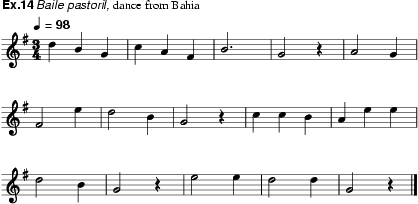
Other important musical occasions are the Easter cycle, and especially the period of Holy Week. Besides certain religious ceremonies such as processions, pilgrimages and folk representations of the Passion, the cycle includes the traditional beating and burning of Judas. For this purpose songs associated with urban Carnival merrymaking are used in the large cities such as São Paulo, since specific songs for the ceremony have become rare. Another ancient European custom observed in Luso-Brazilian folklore is the recommendation of souls during the Lent period. Members of religious groups shroud their heads with white cloths and go at night from house to house to sing and pray for wandering souls believed to be suffering in purgatory or hell. In the hinterland of São Paulo such groups are known as ternos and include children, men and women. They accompany themselves with a matraca (rattle) and a berra-boi (noisemaker) to command attention and to accent the singing. Most typically there are several soloists answered by a chorus, both groups singing in constant parallel 3rds or 6ths.
In addition to the fixed folk festivities, music-making arises in many other social contexts. The large repertory of children's play songs is mostly of Portuguese, Spanish and French origin. Dances and songs accompany all sorts of games and other forms of adult recreation. Similarly, the life-cycle ceremonies for birth, marriage and death are marked by rituals with music, most of which is of Portuguese derivation. Finally, many song repertories arise out of labour activities, such as cattle herding and fishing, cotton, coffee and tobacco picking songs.
Brazil, §II, 3: Traditional music: Luso-Brazilian folk music traditions
Any classification of the many Luso-Brazilian folkdances is necessarily arbitrary. This section does not include dramatic dances, or bailados as they are known in Portuguese, which are discussed in §(iii) below. The traditional classification distinguishes between religious, secular and ‘war’ or fighting dances, although exceptions must be made in the case of dances such as the cateretê, which could be interpreted as semi-religious or semi-secular, without being a fighting dance. Moreover, certain dances cannot be said to belong exclusively to white or mestizo Brazilians rather than to blacks, and vice versa. The determination of the origin of folkdances is virtually impossible in most cases owing to lack of written documentation and as a result of the close interaction of social and ethnic groups. Thus, the looseness of ethnic boundaries should again be borne in mind in discussing folkdances.
Among religious dances the most widespread are the dança de São Gonçalo, dança de Santa Cruz (of the Holy Cross) and cururu. The secular dances, which are more numerous, include the fandango, quadrilha, lundu, jongo, batuque, côco, baianá, carimbó, corta-jaca and the rural samba. Since many of these are more usually associated with blacks they are discussed in §4 below. The fighting dances consist primarily of the Afro-Brazilian capoeira and maculelê. Others in this category are part of dramatic dances, such as the congada, moçambique or cayapó.
The dança de São Gonçalo appears to be one of the most representative of all Brazilian folkdances. St Gonçalo (do Amarante) is a popular saint in the rural areas. Although Portuguese in origin, he has acquired different attributes in Brazil, where he is the patron of viola players and, as a player himself, is always represented with a guitar in his hands. His miraculous function is to promote marriage. The active participants in the dance are generally those who have made a promise to the saint. The performance requires an altar on which is placed a clay statue of St Gonçalo, flanked by two lighted candles. Generally two men sing the prayers and accompany themselves on the viola. The mestre (master), as a rule the oldest man, sings the main melodic line, accompanied in parallel motion by the contramestre at intervals including the unison, 3rd, 4th and 5th. Several couples participate in the dance, forming two lines, men to the left, women to the right, facing the altar. The mestre stands in front of the men's line and the contramestre in front of the women's. In São Paulo state the dance is divided into five parts. For each part, five or six quatrains (usually in heptasyllabic lines) are sung. Each quatrain is accompanied by corresponding choreographic figures, including shoe-tapping. The prayers (Salve regina and an Ave Maria) are sung in alternation between the mestre on the one hand and the contramestre and dancers on the other. The last part of each prayer, including the Amen, is sung by all. The first song (ex.15) is typically in AABB form, A corresponding to the first two lines of text and B to the last two. The most prominent characteristics of this song (also applicable to Luso-Brazilian singing in general) include: predominance of parallel 3rds, transposition to the upper 4th for the B section, anacrusis and isometric phrase structure, and medium melodic range. The Salve regina melody is sung monophonically in a responsorial fashion (ex.16). The Ave Maria collected in São Paulo (ex.17) is typical in its conjunct motion and its rhythmic figures, but atypical in its asymmetrical phrase structure. In most of the São Gonçalo dances (whether from Piauí and Maranhão or Minas Gerais and São Paulo) percussion instruments are rarely used; they are considered unsuitable because the São Gonçalo dance is a ‘dance of respect’. There is no set date for the performance of the dance. Generally, it results from a thanksgiving to a saint in a house or church. In Goiás state, the accompanying ensemble features violin (rabeca), violas, guitars and berimbaus.
Dances and processions for the Holy Cross originate in the Iberian tradition. The whole festivity, which takes place in May, includes secular and religious events, the latter including prayers and the dance known as the dança de Santa Cruz. Crosses are displayed near the entrance door of each house of a village or town and the dance is performed in front of these crosses. While mestre and contramestre with their violas lead the singing, they are accompanied by two adufe (tambourine) players, and sometimes even by an additional cuíca and güiros. All the percussionists also sing. The dance is a circle-dance arranged in two rings, each headed by a viola player. Men and women take their position in each ring without any predetermined order. In São Paulo state, where the dance is most widespread, the musical sequence is in three parts: the ‘greeting’, the round-dance itself, and the closing ‘farewell’. Ex.18 illustrates a greeting song. A particularly characteristic feature of caipira (from the interior of São Paulo state) singing is the final interjection (shown in the last two bars) in which both dancers and audience participate. Most of the songs used in the dance and ‘farewell’ portions of the festivity are similar in melodic contour and rhythm. The rhythmic accompaniment of the violas and adufes varies slightly from one section to another, as shown in ex.19.
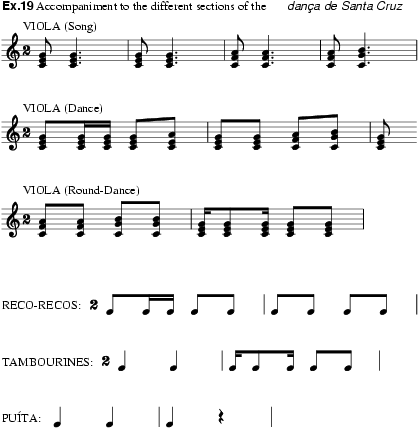
Both the dança de Santa Cruz and the dança de São Gonçalo frequently end with the performance of the cururu, a religious dance, which is generally performed at night, and accompanied by desafios, songs with improvised texts (see §(iv) below). Although improvised, these songs follow a given model referred to as carreira or linha. Here the viola is again the essential instrument. The desafios are not exclusive to the cururu, but the religious content of the song texts seems to be peculiar to that dance. There is a general view, advanced by Mário de Andrade, that the cururu was originally an indigenous dance adopted by the Jesuits in the late 16th century in their missionary work among the Indians. Cururu is believed to be a Tupi-Guarani word meaning ‘toad’, perhaps alluding to certain jumping figures of the dance. The dance takes place in a room adorned with an altar; it is a round-dance, in which the participants follow the musicians (viola, tambourine and reco-reco players) in the circle. In the middle of the circle stands the pedreste, whose function is to initiate the singing, the first part of which consists of toadas de licença (songs of permission, or entrance songs), followed by songs of praise to the saints on the altar and to the owner of the house. The pedreste, however, does not participate in the alternate singing between the cururueiros. The second part involves the singing of carreiras or words serving as models for rhymes, frequently suggested by the pedreste. The improvised lines may have a secular or religious character. The most frequently used carreiras include ‘Divino, Senhor Amado’ or ‘Sagrado, Jesus Amado, Cruz Pesada, Nosso Senhor’ and ‘São João’. It is up to the pedreste to indicate to the two or more improvisers when a subject seems to have been exhausted. Since the singers' attention is concentrated on improvising the text, the melodies of the cururu songs tend to be simple, strictly tonal, avoiding chromaticism, and rhythmically regular in binary (2/4) time. The melodic range is small and melodic contour fairly homogeneous, consisting primarily of conjunct degrees with many repeated notes. The singing is always in duet between the canturião (the main singer) and his segunda (or assistant) who echoes almost simultaneously the improvised words of the canturião. Thus parallel singing in 3rds (ex.20) is a constant feature of the cururu. The instrumental accompaniment, which includes the viola, played rasgueado (strumming), rabecas and reco-recos, stresses dotted rhythms and syncopations.
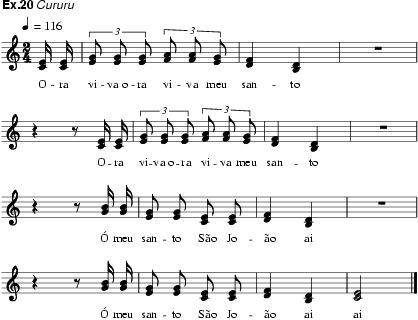
The cateretê or catira, a dance of probable Indian origin used for conversion purposes by the Jesuits, is another popular religious dance. It is found in the states of Rio de Janeiro, Minas Gerais, São Paulo, Mato Grosso, Goiás and several north-eastern states. Two viola players and an even number of exclusively male dancers participate. In certain communities only female dancers are present. The dance takes place generally at night and indoors. Once more the mestre and contramestre sing in duet. Typically the singing is accompanied by regular hand-clapping and shoe-tapping. The choreography comprises four main sections: two facing rows headed by each viola player; an orderly circling around of all participants; a crossover from one row to the other; and finally the hand-clapping and shoe-tapping figures. The songs are known as moda-de-viola, that is, they are narrative and historical in character, always in parallel 3rds and most of the time in a 2/4 metre, with frequent syncopated figures or triplets (ex.21).
The fandango, although a well-known Spanish dance, has been cultivated in Portugal since the 18th century or earlier. In the Brazilian southern states (especially in the Ubá cultural area) the term ‘fandango’ is used generically to designate popular revelry with dances. Thus in Rio Grande do Sul dances associated with the fandango include the anu, balaio, chimarrita, chula, pericom, rancheira de carreira, tatu and tirana. They are all round-dances with hand-clapping, shoe-tapping and finger-snapping. Often castanets are used by female dancers. The songs of most of these dances present the same basic characteristics observed in other dances of Luso-Brazilian folklore, in particular singing in parallel 3rds, as illustrated in ex.22, as well as conjunct, sequential and continuous descending melodic motion, the isometric rhythmic formula with syncopations and feminine cadences and the alternation of stanzas and refrain. The viola is the main accompanying instrument, with an adufe and pandeiro stressing the rhythm. In Rio Grande do Sul, the accordion, locally called gaita, tends to be the main melodic instrument.

In the northern and north-eastern provinces the term ‘fandango’ designates a dramatic dance, otherwise known as nau catarineta or marujada.
The most widespread dance of the fandango in the São Paulo hinterland is the cana-verde, also known in Minas Gerais and Rio de Janeiro. It originated in the Portuguese caninha verde, although it is quite different in character. Generally the dancing and singing are accompanied by violas, reco-reco and tambourine. The song texts in quatrains of heptasyllabic lines and the melodies often starting on an anacrusis are clearly Portuguese traits. Duple metre and eight-bar phrases predominate in the cana-verde songs. The rhythmic structure tends to be very regular, with occasional syncopations.
Brazil, §II, 3: Traditional music: Luso-Brazilian folk music traditions
‘Dramatic dances’ is a term used by Mário de Andrade (1959, 2/1982) for all dances that develop a dramatic action and for collective (group) dances that ‘conform to the formal principle of the suite, that is, the musical work formed by a series of several choreographic parts’. In the late 1940s, Brazilian folklorists also introduced the terms folguedo and auto to designate these dances. Most such dances or bailados were probably introduced or developed by the Jesuits during their missionary work. Thus the subject matter of most dramatic dances is conversion and resurrection. Conversion is the main theme of such dances as congada, marujada and moçambique; while quilombo, cayapó, guerreiros, cabocolinhos and lambe-sujo are concerned with resurrection. Both themes, however, are found in some congadas and marujadas. Although religious in subject matter, these dances include non-religious dramatis personae and secular action. The most general native categories of such dances permit a division into three groups: the baile pastoril, already mentioned as part of the Christmas cycle of folk feasts; the cheganças, used to celebrate Iberian traditions of fights between Christians and Moors and events from Portuguese seafaring history; and the reisados, of varying regional meaning, associated mostly with the Christmas and the Epiphany period. Bumba-meu-boi, the last dramatic dance of the reisados cycle, is the only one truly alive in modern Brazil.
Some dramatic dances are known throughout the country while others are specific to certain regions. In addition, they cut across ethnic boundaries, because as a form of popular theatre developed by missionaries for instructional purposes they affected Amerindians, black slaves and mestizos throughout the colonial period. Indeed their main characteristics combine Iberian and African traditions with Amerindian recollections. With the exception of the baile pastoril, women do not participate in most dramatic dances.
Most bailados comprise two major parts: a danced parade and a dramatic representation referred to in some dances as embaixada (‘embassy’). Both parts include singing and dancing. The maracatu and the taieiras of the north-eastern coastal area, however, omit the embaixada.
In spite of black participation in the congada dance (also known as congos) and the presence of remnants of customs from the slavery period, such as the coronation of black kings, the congada is not considered to be of African origin but simply an adaptation by the catechist of the Chanson de Roland. Throughout Latin America medieval epic poems came to be transformed into folk dramas in the old Iberian tradition of popular theatre. The congada is thus based on the traditional battles between Christians and Moors. As observed in the state of São Paulo, congadas often take place at the celebration of festivities such as the feast of the Divine Holy Spirit (in the last few days of June). They include greeting songs of the ‘Congo’ groups, parade of the ‘battalions’ of the congada and the representation proper. The dramatis personae are numerous. The central characters are the King of Congo or Charlemagne, the General of the Moors, the first and second secretaries, the Moor Ferrabrás, the Christian Duque, Roldão, the prince and the ambassador. The representation is developed in memorized spoken parts as well as solo, duet and choral numbers. Drums accompany the various songs and dances of the ceremony, providing the general rhythm shown in ex.23a. In some congadas from São Paulo a small portable marimba is used in conjunction with an atabaque and a tamborim. Violas and rabeca (fiddle) complete the accompanying ensemble. Responsorial singing predominates. The chorus often includes young boys' voices (an octave higher than the men's). Falsetto singing is quite frequent. There is parallel polyphony in 3rds in many songs. Exx.23b and c illustrate two songs of embaixada, the first one used after the defeat of the Moors, the second to celebrate peace on the occasion of the conversion of the Moors. It is common also to hear songs of praise to St Benedict and St Raphael, the former being the traditional patron saint of Afro-Brazilians.
The marujada (or nau catarineta), a bailado, is known throughout the country by a variety of names, including the erudite terms chegança or chegança de marujos, rarely used by the people themselves. The marujada dramatizes the struggles of the Portuguese in their conquest of the sea, and originates from the period of maritime exploration (late 15th and early 16th centuries). This tradition was transferred to Brazil where an associated song repertory developed, and the dance is still performed in a limited number of rural communities in the northern or south-central regions. The sequences of songs and their melodic traits are fairly homogeneous. In São Paulo the dance was observed during the 1950s and 60s in two coastal towns only. The large number of characters includes a general or admiral, an English captain, a priest, a Moorish king, a prince, a pilot, commanding officers etc. All wear uniforms for the dance. Christians (also called Portuguese or sailors) and Moors (the infidels) are also represented, showing the syncretism of various Iberian traditions. The accompanying instruments are percussion (snare drum and a larger double-headed drum) and fiddles. The singing alternates between soloists (main characters) and chorus (sailors and infidels). The various ‘journeys’ of the dramatization include different types of song and spoken dialogue. The first ‘journey’ is a parade of all the participants hauling a large ship, mounted on wheels for the occasion. Sailor songs (some of Portuguese origin) praising their courage, or warning against pirates and Moors, form the repertory of that first ‘journey’. Loas and romances (respectively, praises and ballads) are either recited or sung in the remaining ‘journeys’. One of the journeys of the marujada depicts a scene of hunger on board. The sailors deplore the situation and sing a celebrated song Triste vida dos marujos (ex.24), so well known that it even appeared in print around the middle of the 19th century. The melody is typical of Portuguese folksong in its 6/8 metre, isometric rhythm, minor mode, range and contour.
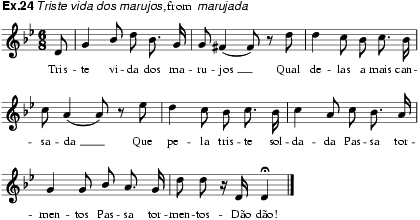
As observed in the state of Bahia, the marujada, performed entirely by Afro-Brazilians, stresses responsorial performance style, with harmonized choral responses (a typical Luso-Brazilian tradition) from singers accompanying themselves with small hand drums. Despite its name, the music accompanying the moçambique dance has no African traits and its origin is obscure, although some scholars believe it is of Afro-Brazilian provenance. In northern Portugal there were formerly festivities honouring Our Lady of Rosario, during which blacks danced in front of the church and in the streets, with decorated sticks in their hands, like the present-day Brazilian moçambiqueiros. These are predominantly black groups dedicated to the cult of St Benedict (they called themselves ‘companies of Moçambique’), performing their dance during the feasts of Our Lady of Rosario and the Divine Holy Spirit. In the 1930s, Mário de Andrade (1959) observed that the moçambique had no dramatic action, and in this respect was like the maracatus from Pernambuco. Subsequent field studies in the 1940s and 50s, however, have revealed embaixada among several ‘companies of Moçambique’, most likely as the result of fusion with elements of other dramatic dances. Choreographically it resembles the battle dances of the congadas. In São Paulo the dancers in opposing lines include stick-fight dancing among the soloists and among all those in the opposing lines. There is responsorial singing between the leader of the dance and the remaining dancers. Percussion dominates the accompanying ensemble. The instruments include snare drum, reco-reco, xique-xique (rattles) and cuíca, in Minas Gerais; in São Paulo the largest ensembles of moçambique groups include violas, guitars, cavaquinhos and fiddles, in addition to tambourines and several rattles of the chocalho types. The dancers often wear jingles (known as paiá or pernamguma) on their feet or legs. The fighting sticks may also have a rhythmic function. Some ‘companies’ seem to follow a certain order in the presentation of their songs, called linhas, or pontos.
The bumba-meu-boi (or boi-bumbá) is the most characteristic caboclo (mestizo) dramatic dance. Because its central figure is a bull (boi), some have interpreted it as a totemistic retention of Amerindian or African cultures. Others have attributed its origin to the old European folk tradition of the bull and donkey in the Nativity scene. Known mostly in the north-east (where it is the most popular dramatic dance) and in the Amazon regions, it is performed during the Christmas season and the St John cycle, respectively. The main characters include the bull, whose head is made of cardboard and worn by a dancer; two or three cattle herders (one of whom, Mateus, is always black); the captain; and a black woman, Catarina. Other animals and fantastic creatures take part in the representation. Only characters representing humans sing. Small ensembles comprise viola, guitar, cavaquinho, accordion, piccolo, fife, clarinet, fiddle and percussion such as zabumba, tambourine, ganzá and maraca. A female chorus introduces and dismisses the characters. Unlike those in most bailados, the vocal parts are generally taken by women. Before the drama begins conventional songs of praise are presented. According to Mário de Andrade (1959), the dance includes both fixed elements consisting of the entrances and dances of the main characters, including the bull, and variable elements, being those of the secondary characters. Specific songs, often similar to cowboys' chanting while herding cattle, are sung to call the bull. Most of the bumba-meu-boi songs exhibit some of the more characteristic elements of mestizo folk music, as in ex.25, which accompanies the dance of the bull: four-bar phrases, descending motion ending on the dominant, isometric rhythm and syncopations. The bumba-meu-boi is perhaps one of the most nationally widespread of the extant dramatic dances. From its figures, costumes, song texts and musical style to its historical evocations and connections, it is the most aesthetically and socially significant folk dramatic expression of Brazil. Several reisados (pastorinha, zé-do-vale, cavalo marinho, burrinha and others) have been incorporated into the bumba-meu-boi.
Other dramatic dances of indigenous origin, but now rarely performed, include the caiapó, cabocolinhos and some with clearly African features such as the taieira (still known in Sergipe), the quilombo and the lambesujo, all more specifically from the north-eastern states.
Brazil, §II, 3: Traditional music: Luso-Brazilian folk music traditions
There is a large repertory of monodic songs with a variety of functions in Luso-Brazilian folk music, such as work songs, street-vendors' chants, ballads, love-songs, lullabies, children's songs and laments for the dead. Only a few will be described.
The word romance, of Iberian origin, designates narrative poetry or singing in general. Brazil inherited a rich Iberian romanceiro, or ballad repertory, the majority dating from the 16th and 17th centuries. These ballads seem to have originated mainly in the Minho region of Portugal. They are often used as lullabies, children's game songs, and modinhas. These song genres therefore share many musical traits with the Iberian romances, such as predominating triple metre and minor mode, literary origin, traditional song texts set in quatrains and heptasyllabic lines with consonant rhymes. Ex.26, collected in 1949 in São Paulo state, illustrates the ‘Bela infanta’ theme common in the Iberian ballad. Notable features are the anacrusis and the symmetrical phrase length corresponding to each line of the quatrain. Ballads which deal with animals or celebrated outlaws are quite common, especially in the north-eastern regions. In the romances concerning the cangaceiros (north-eastern bandits) the strength and courage of the characters are always particular subjects of praise. The narrative in such ballads is told in the third person. In the animal cycle, however, the animal is personified and becomes the story-teller. In the romance of the bull Surubim (ex.27) the rhythm, with its syncopations, triplets and dotted figures, is more clearly Brazilian, though it retains some Iberian melodic features.
Many other forms of narrative singing, such as the modas, modas-de-viola, abecês, décimas or xácaras, are closely related to the Iberian ballad. The moda and moda-de-viola are sung as duets in parallel 3rds with viola accompaniment. The singers (modistas) are also viola players. One of the main differences between the southern and northern modistas is that the latter, as part of the cantoria (singing contest) tradition, rely more on improvisation. In addition, the southerners tend to use falsetto more frequently.
The genres known as desafio and embolada, although often appearing as part of dances, are more properly song types. Desafio (literally ‘challenge’) is a song genre (also common in southern Europe), in which two or more singers compete to show their skill in improvisation. The contest lasts until one of the singers can no longer respond or gives up. Text improvisation is considered the primary point of interest of the desafio, while the melody is subordinate. The textual form is generally the quatrain, the last line of which often becomes the first of the respondent's quatrain. The melodic structure of desafios tends to be simple, with melodic sequences and isometric rhythm, to allow proper attention to text improvisation and delivery. Desafios are particularly popular in the north-eastern hinterland, the area of cantoria (singing contest) par excellence.
Embolada, a musical-poetic form often associated with northern dances such as the cocos, alternates a fixed refrain with stanzas (sometimes improvised). It consists of a recitative-like melody with small intervals, repeated notes and small note values. The text, often comic and satirical, stresses onomatopoeia and alliteration which, with a fast tempo, enhance the rhythm of the song. The embolada is also frequently associated with other contexts involving singing but not dance, such as the desafio. A large repertory of children's game songs is found throughout the country. Many have retained Portuguese, Spanish and French melodies. One of the most traditional round-games is the ciranda or cirandinha, similar to the ‘Ring-a-Ring of Roses’ game, accompanied by the melody shown in ex.28, known with slight variants in both Brazil and Portugal. Other songs for round-games exhibit more typically Brazilian traits such as systematic syncopated rhythm.
Although the modern age of machinery has partially modified the custom of singing at work, radio music often taking its place, some work songs continue to be sung. The aboios (cattle herding songs) are quite widespread, as are the songs of river-boat workers, fishermen and those who work on rice, coffee and cotton plantations.
There are two types of aboio: the aboio de roça and the aboio de gado. The former is always sung in duet, to a text in the form of statement and answer, when one or more cowboys lead the herd and the others follow behind it. The latter is a solo song, sung to a single syllable, to quieten the cattle in the corral. The north-eastern aboios are characterized by ornamental melodic lines, wide range and frequent use of falsetto.
Of the various death rites, the velório or wake is the most important. In the northern states wake songs or laments are known as incelências or excelências, and are of Portuguese origin. They are sung around the dead body and are believed, in some areas, to help the departed enter heaven. Up to 12 lines are sung, unaccompanied and generally in unison. Wake prayers, however, such as those for cleaning and dressing the corpse, are in parallel 3rds. Other wake songs function as a ‘farewell’ to the dead.
Brazil, §II: Traditional music
The main geographical zones of Afro-Brazilian culture include the states of Pernambuco, Alagoas, Sergipe, Bahia, Espírito Santo, Minas Gerais, southern Goiás, Rio de Janeiro and northern São Paulo. It is practically impossible to point out specific African cultural origins of most Afro-Brazilian musical genres, since several African cultures were in close contact from the outset of the slave trade. It is generally recognized, however, that most Afro-Brazilian secular music is of Bantu origin, while Yoruba and Fon influences are particularly noticeable in religious beliefs and music. Just as blacks participate in most of the dramatic dances already described, there are likewise specifically black festivities in which mestizos and whites also take part. While black music in Brazil has stylistic features which can be traced to West Africa, the actual repertories were, in all probability, created locally. African counterparts have been found for only a few religious melodies, though it is possible that Brazil may have retained African songs which have since disappeared in Africa itself.
In spite of its heterogeneous cultural origins, black folk music in Brazil became homogeneous during its four centuries of history. What developed during the slavery period into a new black culture resulted from the conditions of plantation slave quarters. The new form of black and anti-white solidarity which emerged out of these conditions helped to preserve cultural traits that still survive. Thus religious beliefs and practices in Brazil are still the most truly ‘African’ to be found in the Western hemisphere.
(i) Dances and dramatic dances.
Brazil, §II, 4: Traditional music: Afro-Brazilian folk music traditions
The black contribution to and influence on Brazilian folkdances is paramount. This is reflected not only in the large number of Afro-Brazilian dances, both rural and urban, but also in the assimilation and resulting transformation of European dances. Choreographic elements of such dances include round formation, usually with soloists, and a particular trait known as umbigada (from Portuguese umbigo: ‘navel’). This is an ‘invitation to the dance’ symbolized by the touching of the couples' navels. It may be taken as an indication of the origin of the dances.
Because music and dance are often inseparable the name of a dance is also applied to the music it accompanies, thus becoming a generic term, of which batuque and samba represent the most obvious examples. Both have come to designate genres of secular dance and music of Brazilian blacks. The caxambu, jongo, côco, baiano (baião) and formerly the lundu and sarambeque, with numerous regional names, are among the most important other dance genres. Generally considered a round-dance of Angolese or Congolese origin, the batuque is no longer performed and the term has acquired the more general connotation of Afro-Brazilian dance accompanied by heavy percussion. In São Paulo state it is a dance of Afro-Brazilian fetishistic cults, without any apparent liturgical function. The accompanying instruments include drums (tambu, quinjengue) and rattles (matraca, guiaiá). The dance itself is not a round-dance, but consists of umbigadas between two facing lines of dancers, males on one side, females on the other. Individual couples dance between the rows. Responsorial singing accompanies the dance. The singers are called modista or carreirista according to the type of song they improvise. The modista sings quatrains referring to community events or gossip, while the carreirista's songs, called porfias, are hostile and challenging. Improvisation and responsorial singing are not necessarily opposed practices, since the chorus tends to repeat literally or with slight variants the improvised two lines of the quatrain. Before the dance begins, the song is rehearsed collectively for 10 to 20 minutes. In addition, the modista or carreirista and the chorus all consult together regarding the general outline of song text and method of performance.
There are many varieties of samba. As a folkdance it has lost its former importance in most parts of the country, having been replaced by the urban samba. The folk samba in the southern-central regions is known as samba-lenço, samba de roda and samba campineiro. The samba-lenço involves dancers with a kerchief in their hand; the choreographic arrangement is similar to that of the batuque. At the beginning of the dance two singers, accompanied on snare drums and tambourines, sing in parallel 3rds. The songs are usually eight bars long, in duple metre, with an anacrusis, a range of up to an octave, descending motion with repeated notes and isometric rhythm (ex.29). Syncopations often associated with black music prevail here in the accompaniment alone. Song texts are in the form of quatrains.
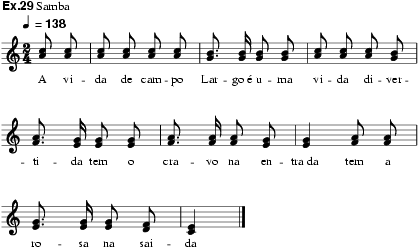
The samba campineiro was studied by Mário de Andrade (1937), who preferred the simple designation ‘Paulista rural samba’. Andrade observed that in São Paulo the samba is defined by its choreography rather than by its musical structure. This dance does not include the umbigada and is thus essentially collective in character. Apart from the instrumentalists (who also dance) the participants are women. The main instrument is the bombo (large drum), often accompanied by tambourine, snare drum, tamborim, cuíca, reco-reco and guiaiá. Structurally this samba shows the following traits: arched melody in 2/4 metre; characteristic rhythmic figuration (ex.30); strophic form and variable text form; repetition of words or lines to conform to the melodic length; and relative importance of improvisation.
![]()
The samba de roda in São Paulo has lost its former importance, but in the north-eastern region (especially the state of Bahia) it is still the most popular type of folkdance. As the name indicates, it is a round-dance involving soloists; its function is purely recreational. The instrumental ensemble includes atabaques played with the hands, tambourines, cowbell and occasionally guitars. Traditionally singing precedes the dance itself, but the song has now become an integral part of the dance. The most typical samba de roda songs display an unmistakably Brazilian flavour, characterized by four- or eight-bar phrases, repeated notes, isometric rhythmic figures and abundant syncopations in the accompaniment. The tunes frequently end on the mediant or dominant. Two different types of samba de roda are shown in ex.31.
Another genre of samba particular to the Bahian region (specifically the recôncavo, the area around the Bay of Todos os Santos), is the samba de viola, studied by R.C. Waddey and T. de Oliveira Pinto. As the name indicates, the viola is the main instrument. The presence of this instrument in a most typical Afro-Bahian genre, performed by Afro-Bahians, shows that the instrument of Portuguese origin has become equally Afro-Brazilian. The Bahian viola is hand-made in two sizes: three-quarter (90 cm long) and the machete (76 cm long), both with five double courses of metal strings. As a rule, the percussion of the ensemble includes two ot three tambourines, a small drum and sometimes the prato-e-faca, a common plate (preferably enamelware), held in one hand and scraped with a table knife. Instrumentalists (all male) also participate in the singing. The songs (both melodies and song texts are referred to as chulas) are performed in parallel 3rds and in a very high tessitura. The dancers tend to be exclusively women.
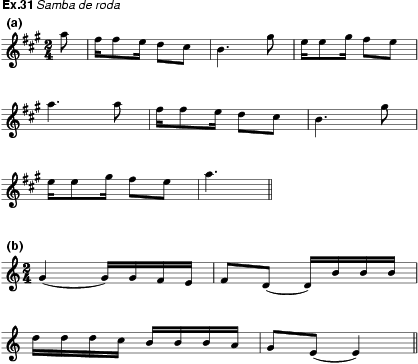
Jongo, a dance of African origin (from Angola according to some authors), survives in a few places in the southern-central states, where there was formerly a large black slave population. It is social and recreational. Men and women participate in both solo dancing and round-dancing (always anticlockwise). The singing and the texts are referred to as pontos, as in several Afro-Brazilian religious groups. The dance is usually accompanied by the same instruments used for the batuque and the rural samba. In São Paulo state the singing is performed by a cantador, sometimes helped by a second voice (in parallel 3rds), and answered by the chorus consisting of the dancers themselves. Most of the pontos seem to be improvised; these include the pontos de desafio (challenging songs) with enigmatic texts and the pontos de visaria or songs to accompany the dance. Pontos may have one or two voltas (two-line verses). The most common traits of jongo songs include two-bar repeated isometric phrases, prevailing conjunct motion, parallel singing and syncopated percussion accompaniment (ex.32).
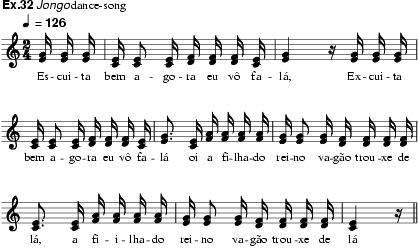
The côco is a dance of the poorer people in northern and north-eastern Brazil, and is so called because it is commonly accompanied by hand-clapping with hands cupped to create a lower sound, like that of two halves of a coconut shell sounded against each other. Occasionally a drum or a rattle may be used, in which case the dance is named after the instrument: côco-de-canzá, côco-de-mugonguê etc. In the northern states different names refer to the type of song associated with the côco, such as côco-de-décima, côco-de-embolada, côco-desafio. The choreography dictates the alternation of stanza and refrain in the song, as a solo dancer in the middle of the circle improvises a stanza and is answered by the other dancers. A common trait of côco song melodies is the peculiar rhythm of short note values (generally semiquavers in 2/4 time) repeated continually, resulting in a sort of moto perpetuo.
The maracatu dance–procession is specifically associated with Carnival in the city of Recife in Pernambuco. Its origin seems to be related to the festivities for the coronation of black kings, first mentioned in 1711. Formerly maracatu was purely religious and was closely related to the Afro-Brazilian cult of Xangô, but this function seems to have been lost, for it now consists of an organized group of Carnival street-dancing merrymakers. The main characters include the king, queen, princes, ambassador, dama-do-paço (‘court lady’) and the baianas, or female dancers. The ‘court lady’ is the central figure of the royal parade, as she carries the calunga, a small doll dressed in white, which represents a relic of fetishistic cult and a symbol of authority or priestly power. The various toadas (songs) of the dance and procession frequently allude to African deities. Songs and dances are related to the calunga on which the attention of all participants is focussed. The accompanying ensemble consists of percussion instruments, various types of drum (tarol, caixas, zabumbas) and the gonguê or agogô (cowbell); the different timbres enhance the polyrhythmic texture of the ensemble. The rhythm of the songs also displays systematic syncopation, as illustrated in ex.33. Probably of similar origin to the maracatu is the afoxé from Bahia which, however, retains more clearly African elements, such as singing in Yoruba language (Nagô), and typically Afro-Brazilian ritual practices in the preparation of the dance-parade.
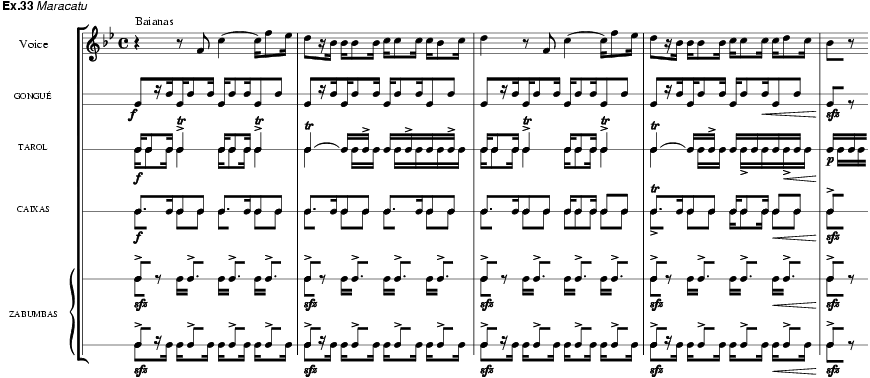
Although considered primarily as an athletic game and a martial art by some authors, the capoeira angola – a mock fight involving several dance figures – also has ritual overtones. Most capoeiristas (fighters) are cult men and observe their prescribed ritual behaviour in the practice of capoeira. The various dance figures or ‘strokes’ are accompanied by songs in responsorial fashion and by an instrumental ensemble consisting of two or more berimbaus (musical bows), caxixi (basket rattle), reco-reco or ganzá, tambourines and conga drum. Specific rhythmic patterns, with names such as São Bento grande, São Bento pequeno, Benguela, Cavalaria, Santa Maria, Angola etc., correspond to specific ‘strokes’ of the dance. About 139 songs of the capoeira game have been collected in Bahia, but not all belong to the traditional repertory of the dance, many having been borrowed from children's round-game songs or samba de roda song repertories. In these songs it is not uncommon to find the same type of syncopation applied to both vocal line and instrumental accompaniment. In the latter, the harmonic support of the musical bows is notable; since each instrument is capable of producing two adjacent notes, three bows can provide parallel harmonies repeated at will (ex.34). In the 1960s capoeira performances were limited to about a dozen songs, as the performance venues became restricted to restaurants and other tourist attractions. Another Afro-Brazilian fighting dance is the maculelê, strongly reminiscent of black African stick-fighting dances. The sticks are used as mock weapons and as a percussion instrument.
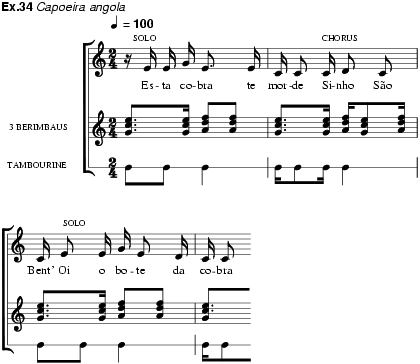
Brazil, §II, 4: Traditional music: Afro-Brazilian folk music traditions
It is difficult to isolate specific song genres peculiar to the Afro-Brazilian cultural heritage. Most of the songs described in §3(iv) are also sung by blacks and mestizos. In addition, there are a few song genres that are autonomous, that is, existing outside their function in a given dance or dramatic dance. Among these song types are work songs, lullabies and, above all, songs related to Afro-Brazilian religions. Fishermen's songs in the fishing area of the north-eastern coast reveal some stylistic traits which could be attributed to an African origin. These include pentatonic scales, E modes, descending or undulating melodic movement and frequent syncopations. The songs of the puxada da rêde or xaréu (the pulling of the fishnet), on the other hand, have the same general characteristics observed in Brazilian mestizo music. Ex.35 shows the same anacrusis, repeated notes, isometric rhythm and tonal feeling of so many other song types mentioned above.
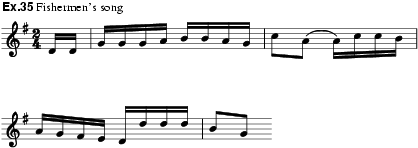
Brazil, §II, 4: Traditional music: Afro-Brazilian folk music traditions
The extremely rich and varied repertory of religious music is primarily of Afro-Brazilian origin. Although it is in a sacred context that African musical elements are most strongly preserved, syncretism has affected not only religious beliefs and practices but also the music associated with them. Among the most African cults are the Ketu (or Nagô) and Jesha (Yoruba), the Gêge (Fon of Benin) and the Congo-Angola, found in the northern and north-eastern states. The least African groups are the Caboclos (derived from some Amerindian beliefs combined with those of other cult groups), Pajelança, and the Umbanda and Quimbanda, found mainly in the central and southern regions, though Umbanda has now penetrated practically everywhere.
Candomblé is the term used specifically in Bahia to designate various religious groups of African origin. As a result of the contact of several prevailing African cultures in Bahia, candomblé became a sort of cultural synthesis of the West African mythological world. Most candomblé houses in Bahia worship the major Yoruba and Fon deities (orixás and voduns) as opposed to the West African practice in which a religious centre (and sometimes an entire village) is dedicated to the worship of one particular orixá or vodun. The earliest establishment of the Yoruba slaves' religious organization in Bahia is difficult to determine accurately. According to local oral sources it was around 1830 that the first cult centre was founded in Salvador by three African priestesses. This centre, of Ketu affiliation, was known as Ilê Iyá Nassô, and from it originated the largest and best-known houses of worship during the 20th century, especially the Engenho Velho (also known as Casa Branca), the Gantois, Ilê Axé Opô Afonjá and the Alaketo.
The most obvious stylistic trait common to the music of all these groups is monophonic singing and the predominant use of call and response patterns. In addition, the singing is accompanied by an ensemble usually consisting of three drums (atabaques of varying sizes) and an agogô (cowbell) or a shaken rattle. Leader and chorus often sing the same tune, sometimes related tunes. Quite often soloist and chorus overlap. Melodies are often anhemitonic pentatonic in the most traditional repertories, and diatonic (heptatonic) in the most acculturated ones. The ranges of the melodies are not uniform. The Gêge and Ketu cults of Bahia, for example, have many songs with a wide range of more than an octave, while those of the Angola and Jesha cults in the same area average less than an octave. Melodic contours tend to be descending in all repertories, with undulating movements also characteristic of the Ketu and Gêge repertories. Almost all the songs in all the groups are strophic.
Cycles of songs are performed in a ritual order, dictated by their function. There are food-offering songs, sacrificial songs, plant songs, initiation songs, death songs etc. A multitude of songs addressed to the many deities of West African mythology form the bulk of the repertories. Song texts appear in many languages, from Yoruba (Nagô), Fon and various Congo dialects to Portuguese, and a combination of all of these.
Drumming constitutes one of the most important musical elements of Afro-Brazilian religious music. Drums are considered sacred instruments and undergo ‘baptism’ by means of animal sacrifices and food-offering. Since they are believed to have the power to communicate with the deities, the drum's axé (or spiritual force) is ritually renewed at least once a year. There is a great deal of drum music for drums alone. Besides providing the basis for the many ritual dances, drum music ‘calls’ the gods and brings on spirit ‘possession’. In the Ketu cult specific rhythmic patterns are associated with certain deities, such as the alujá of Xangô, the opanijé of Omolú, the aguerê of Iansã and Oxossi, and the igbim of Oxalá. Cross-rhythms and polyrhythms predominate. The metres are most commonly duple but often also triple, with frequent hemiolas; a subtle duple-triple ambivalence is also characteristic. The master drummer playing the largest drum (rum) of the trio improvises upon the characteristic rhythms and at the same time controls the choreographic development of the ritual dances. Exx. 36 and 37 illustrate some of the characteristics of Afro-Brazilian cult songs. Few of these songs are known in West Africa, although their style is unmistakably African. Among the most acculturated groups (Caboclo, Umbanda) the repertories seem to be constantly changing and tend to be heavily influenced by urban popular music.
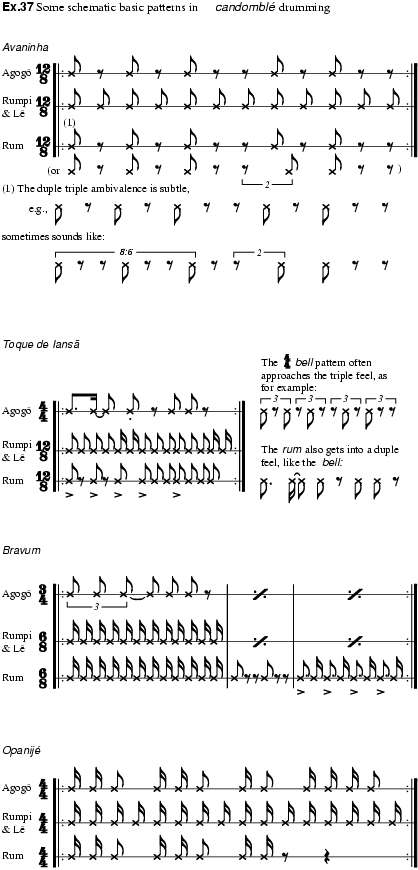
Since the latter part of the 19th century Brazil has developed one of the richest and most varied and unique traditions of popular music in Latin America. Several trends and genres since the 1960s have become an integral part of the international world music market and have influenced the USA, Portugal and other European countries, as well as some African countries. There is no single Brazilian popular music but various expressions associated with specific social classes, regions and historical periods. The main sources of such musics are predominantly European, Afro-Brazilian and mestizo. Influences from American Tin Pan Alley songs, dance music, jazz, rock and more specific black American genres, as well as Caribbean popular music (especially from Cuba, Dominican Republic and Jamaica) have been felt in Brazil
2. Urban sambas and related genres.
6. Dance music of the north and north-east.
The belle époque of Brazilian popular music took place in and around the cities of Rio de Janeiro and Salvador, Bahia, from about 1870 to about 1920, when the 1888 abolition of slavery led to wholesale migration from the rural areas to the towns. During this 50-year period, an increasing diversification of musical forms, rhythms and social contexts for popular music consumption resulted in the emergence of the most important vocal, instrumental and dance genres developed during the first half of the 20th century.
Salon music of the 19th century was represented by the sentimental song known as Modinha, the stylization of the lundu, an earlier dance of Afro-Brazilian origin, as lundu-canção (lundu-song) and the adaptation of a number of European fashionable dances, especially the polka, waltz, schottish and quadrille. Modinhismo was the term used by Mário de Andrade to encompass the repertory of romantic, sentimental songs of European derivation which remained visible in numerous subsequent genres of popular songs. Besides Domingo Caldas Barbosa, composer of famous modinhas and lundus, some of the most celebrated 19th-century popular composers included Domingos da Rocha Mussurunga, José de Souza Aragão (‘Cazuzinha’), Xisto de Paula Bahia, Francisco Magalhães Cardoso, Joaquim Manoel, José Pereira Rebouças and especially Cândido Inácio da Silva. Their works were frequently performed in the aristocratic salons and in popular theatres (teatro de revista) of the period, which represented one of the major venues for the dissemination of popular music among the urban middle class.
From about 1850 the European waltz and polka became ‘brazilianized’, the former under the influence of the modinha and the latter combining with certain rhythmic traits of the lundu to form the hybrid polca-lundu, the source of the tango brasileiro and the Maxixe. Waltzes, polkas and quadrilles written for the piano were frequently adapted for plays and comedies, notably by the pianist-composer Antonio F. Cardoso de Menezes e Sousa. Likewise, the generic canção and cançoneta (which represented the lyric, romantic song) was hybridized with tango-habanera rhythmic accompaniment as tango-cançoneta. Popular singers of the early 20th century, especially Mário Pinheiro (c1880–1923), Baiano (Manuel Pedro dos Santos, 1870–1944), Cadete (Evênio da Costa Moreira, 1874–1960) and Eduardo das Neves (1874–1919), began recording many of these vocal genres, some as early as 1902. Later singer-idols of various songs, operettas and fashionable urban sambas were Vicente Celestino (1887–1968) and Francisco Alves (1898–1952).
The most successful and prolific composer of theatre pieces (operetta, burlesque, vaudeville and musical comedy), polkas, waltzes, songs, modinhas, tangos and choros was Chiquinha Gonzaga (1847–1935), who overcame the prejudices against female musicians and composers both of her family and more generally the period. Together with Joaquim Antônio da Silva Calado and Ernesto Nazareth, she contributed substantially to the nationalization of European dances. Her polka Atraente (1877), for example, effectively imitated the type of picturesque improvisation associated with popular strolling musicians known as chorões (‘weepers’) and their instrumental ensembles (Choro). This improvisatory style was made up of typical running figures including broken-chord patterns with repeated notes, descending chromatic notes in the accompaniment and isometric figures. She also systemized the use of the habanera rhythmic pattern, with subtle variations and syncopated patterns (such as the semiquaver–quaver–semiquaver pattern in a 2/4 metre), characteristic of later dance music genres. Chiquinha Gonzaga wrote the first carnival dance of national interest in 1899 for the black Carnival society Rosa de Ouro. This was the march O abre alas! which for several decades symbolized Rio de Janeiro's carnival.
It was, however, with the works of the pianist-composer Ernesto Nazareth that a deeper transformation of European dances into genuinely Brazilian popular genres was achieved.
Although the first acknowledged successful commercial recording in Brazil of an urban Samba is generally said to have been Pelo Telefone (1917) by the composer Donga (Ernesto Joaquim Maria dos Santos, 1891–1974), the antecedents of the most typical urban dance–song of Brazil date from the turn of the 20th century. At that time, however, ‘samba’, as labelled by leaders of small town brass bands, did not differ markedly from the tango or the maxixe, except to imply a more systematically syncopated accompanimental rhythm. Pelo telefone, a hit of the 1917 Carnival celebration, while registered as ‘samba’, still had the shuffling rhythmic feel associated with the maxixe. It is quite likely that the folk samba, a round dance involving dancing couples performing the umbigada in typical round choreographic figures (especially associated with Rio de Janeiro and Bahia), was the model developed in the urban areas. The call-and-response performing style and corresponding stanza and refrain alternation cultivated in the samba de morro (from the poor hill areas of the city, known as favelas) and the partido alto (brought to Rio from Bahia at the beginning of the century) subsequently influenced numerous urban samba styles developed in the 1920s. As a generic type of urban music, the samba is essentially a vocal dance genre, with a few exclusively instrumental subgenres such as the samba-choro and samba de gafieira. The urban samba became established in Rio during the 1920s, especially through the compositions of Sinhô (José Barbosa da Silva, 1888–1930), the ‘king of samba’, Caninha (Oscar José Luiz de Morais, 1883–1961), Ismael Silva (1905–78) and Pixinguinha (Alfredo da Rocha Vianna Filho, 1898–1973). All represented a professionalized group of lower middle-class black composer–performers who were well acquainted with the musical traditions of the poorer sections of the city. Sinhô composed the greatest carnival hits of the late 1910s and the 1920s, such as the sambas Quem São Eles (1918), Confessa, meu bem (1919), Fala, meu louro (1920), Amor sem dinheiro (1926), Ora, vejam só! (1927) and Amar a uma só mulher (1928), in addition to carnival marches. Caninha's sambas Me leve, me leve, seu Rafael and Esta nêga quer me dar were among the hits of the 1920 and 1921 carnival seasons, respectively. As a composer, flautist, saxophonist, bandleader and arranger, Pixinguinha had an enormous influence. His bands Os Oito Batutas (first organized in 1919), Orquestra Típica Pixinguinha-Donga (1928) and Guarda Velha (1931) brought together some of the best popular musicians of the period and contributed to unique performance styles that became classic. Guarda Velha put more emphasis on brass and achieved a perfect balance between virtuoso solo performances and deeper concern for ensemble playing.
During the 1930s a number of white middle-class professional composers contributed to the development of the urban samba. Particularly significant and creative were Ari Barroso (1903–64), Noel Rosa (1910–37), Lamartine Babo (1904–63) and João de Barro (Alberto Ferreira Braga, b 1907, also known as ‘Braguinha’). Not only did they all compose sambas and marches for carnival that enjoyed lasting popularity but they also created some of the most famous tunes associated with the sophisticated samba-choro, samba-canção (samba-song of sentimental character) and ballroom or nightclub sambas. This was the period during which the samba became more diversified as a result of its acceptance by the various local strata. Noel Rosa especially excelled in reflecting some of the typical attributes and feelings of urban popular figures, as in Feitiço da vila, Palpite infeliz and Fita amarela. Among other genres, he especially cultivated and developed the samba de breque (samba brecado), a subgenre of the urban samba involving everyday colloquial lyrics with a characteristic break (breque) and a corresponding interruption of the melodic line, that appears to be extemporized on a humorous or joking note. Notable examples include De babado, Conversa de botequim and Três apitos. The 1930s represented the golden period of the classic urban samba, followed by the creation of other subgenres beginning in the 1940s, such as the strictly instrumental, highly syncopated samba de gafieira, created by dance orchestras in gafieiras (popular dance halls) and cabarets. While large jazz-like orchestras performing arrangements of classic samba tunes for dance occasions developed in the 1940s and 50s, the influence of modern jazz small combos was particularly felt in the so-called samba–jazz of the 1950s. The best-known performers of the classic commercial samba from the 1930s to the 1950s were Carmen Miranda (1909–55), Francisco Alves, Mário Reis (1907–81), Sílvio Caldas (1908–98), and Elizeth Cardoso (1920–90).
The co-existence of various samba subgenres, from the samba de morro and samba-enredo, associated with Carnival and the samba school, to the [samba de partido alto], samba-canção, sambolero and sambalada, among others, clearly manifested the social acceptance of the samba, in its varied expressions, as the national dance music. It also reflected the strong social stratification prevailing in the large cities of the post-World War II era. In Rio de Janeiro especially, urban geography created a pronounced social separation, with the poor living in the northern areas and hilly ghettos and the rich along the southern beach districts from Leme to Leblon, where the famous bossa nova movement was born in the late 1950s.
It is important to remember that Bossa nova does not constitute a special genre of Brazilian popular music, but rather a characteristic performance style of established genres. The very first recording (1952) in Rio by João Gilberto (b 1931), one of the early and most influential bossa nova figures, originally from the interior of the state of Bahia, comprised two pieces in the samba-canção genre, composed by musicians of the younger generation. In the late 1950s and early 60s, most of the bossanovistas were in their late teens and early twenties and belonged to the middle and upper-middle classes. Their musical tastes gave preference to a combination of samba-canção as performed by the great female vocalists Dolores Duran, Maysa and Sylvinha Telles (the creators of the so-called Brazilian blues); the music of various jazz figures, especially the voices of Sarah Vaughan and Ella Fitzgerald, the cool style of Miles Davis and the sophisticated and subtle harmonies of Joe Mooney; and some of the classic sambas of the 1930s. The bossanovistas looked to innovatory expressions that would renovate and modernize Brazilian popular music. Young jazz enthusiasts in Rio and São Paulo were involved at that time in the creation of a ‘samba jazz’ tradition, in a jazz combo format, which represented a natural ingredient of the bossa nova movement. This was not, however, a simple imitation of American jazz or, as José Ramos Tinhorão has reiterated since 1966, the capitulation of Brazilian musicians faced with international market pressure for fashionable and commercially viable genres and styles. To interpret bossa nova as a repudiation of the heritage of the popular samba and the result of socio-cultural alienation suggests a short-sighted perspective on the motivation for musical change. In effect, bossa nova represented a revolutionary innovation only in its new rhythmic rendition of the samba beat, the nature and quality of its lyrics and its general performance practice.
In the opinion of some critics, the poetic sophistication of bossa nova song texts alienated the cultivators of the new style from popular cultural roots. Thematically, however, the subject matter of early bossa nova songs differed little from previous songs, covering amatory topics (e.g. Jobim's O nosso amor, written with the great poet Vinicius de Morais for the 1958 film Orfeu da Conceição [‘Black Orpheus’]), devotion to nature mixed with romantic introspection (Jobim's Corcovado), philosophical commentaries (Jobim's Chega de Saudade, Desafinado, Discussão and Samba de uma nota só) and narratives describing typical local figures or dances in the context of urban life (Jobim's Garota de Ipanema and Samba do avião). Traditional romantic love themes continued to represent by far the majority of bossa nova songs, which inherited such themes from previous popular genres, especially the samba-canção.
But if the thematic categories did not change radically, the poetic substance and treatment involved drastic innovations. Beginning in the 1950s with poets of the calibre of Vinicius de Morais, bossa nova music of the 1960s and 70s counted on the unprecedented poetic refinement and creative originality of such composer-poets as Newton Mendonça, Chico Buarque, Capinam, Torquato Neto, Gilberto Gil and Caetano Veloso. The deliberately intimate character of bossa nova expression called not only for simplicity of language (reinforced by colloquialism), but also for the specific sound effects of the words, showing some affinity with Brazilian concrete poetry of the 1960s. This remarkable preoccupation with the language's sounds was also reflected in the close relationship of text and melody in many songs, where the lyrics do not seem to have been conceived separately from the music itself. Of all bossa nova composers, Antônio Carlos Jobim (1927–94) was the most creative and internationally successful.
Until 1964, the year of the military take-over in Brazil, bossa nova aesthetic ideals remained unchanged. After that time, however, a new social awareness developed among bossa nova musicians. The best example of a musician–poet with enormously creative powers and a vivid social consciousness is Chico Buarque (b 1944), the son of one of Brazil's most noted historians. In 1965 his first songs Pedro Pedreiro, and Sonho de um carnaval brought him public recognition. Sonho de um carnaval, more than any song of the bossa nova repertory at that time, established a clear and clever link with the traditional samba of the 1930s and 40s and carnival music in general. Pedro Pedreiro, on the other hand, initiated among bossa nova musicians the trend towards social participation and protest. Other songs of the same year (e.g. João do Vale's Carcará which launched the singing career of Maria Bethania) also belonged to this general category of social protest songs, but most frequently the protest took the form of exposing some of the social problems of under-development, hunger and injustice in the distant hinterland of the north-east. With Pedro Pedreiro Chico Buarque took issue with the urban conditions of north-eastern migrant workers in large southern cities, revealing an understanding of the conditions of the urban working class. The concentrated poetic language full of emotional impact exhibited in this song became highly sophisticated in later songs, particularly Construção of 1971.
Chico Buarque's position in the ‘modern’ movement of Brazilian popular music (referred to as MMPB for Moderna Música Popular Brasileira) has been variously interpreted, most critics arguing that his ability with lyrics rather than his actual music is the source of his popularity. He is, however, unique as a composer of the second bossa nova generation in that he succeeded in assimilating and maintaining the essential melodic and rhythmic aspects of the classic sambas of Noel Rosa, and thus established the continuity of the tradition, in contrast to the first generation of bossa nova musicians. In many of his later songs he advocated in lyrical and poetic ways a subtle action of subversion and anarchy as the only response to Brazil's contemporary problems, which led to the censorship of so many of his songs by the military regimes of the late 1960s and early 1970s.
Around the mid-1960s a group of musician-poet-performers known as Tropicália, mostly from Bahia, emerged on the Brazilian scene. Including such different personalities as Caetano Veloso, Gilberto Gil, Gal Costa, José Carlos Capinam, Torquato Neto, Tom Zé, the bossa nova singer Nara Leão and the composer-arranger Rogério Duprat, the group's essential common denominator came from the adherence of its members to the basic concepts of modernismo set forth in the 1920s by such literary philosophical figures as Oswald de Andrade and Mário de Andrade. In the words of Caetano Veloso, the theoretical spokesman and leader of the group, Tropicália or tropicalismo was neo-cultural cannibalism or anthropophagism. Influenced by the French Dadaists whose manifesto was written ten years earlier and consisted of a violent attack on Western thought, Oswald de Andrade's own manifesto (Manifesto antropofágico, 1928) appeared as a tropical adaptation of Dadaist dissension, questioning the imposition of the European element in Brazilian culture and the ensuing destruction of native cultural values. The question was whether or not one should return to native cultures still found in a state of purity, or whether one should acquire the tools and skills of other cultures. While Andrade attempts no clear-cut answer, he points out the apparent contradictions and contrasts of the Brazilian reality. For the Tropicália musicians, this was a justification of the absorption of foreign musical experience adapted to the needs of the moment and a recognition of the international dimension of Brazilian popular culture of the period. Such a recognition, however, neither implied a simple imitation of foreign models nor resulted from the influence of international mass culture, as several critics believed at the time (Tinhorão, 1974, p.234). For the Tropicália group, modernism not only signified revitalization through innovations of MPB (Música Popular Brasileira) , but also the definite involvement of its members in prevailing socio-political conditions. Setting out to shock deliberately and to concertedly denounce the contradictions in Western thought, their aim was to awaken the consciousness of the middle class to the Brazilian tragedy of poverty, exploitation and oppression and to point out the true nature of modern Brazil.
Musically, the movement brought about the widening of the Brazilian musical horizon through adherence to and adaptation of musical trends of the 1960s: the rock and Beatles phenomena and the experimental new musics of the electronic age. Rock music penetrated the Brazilian scene during the period 1964–6 and had, in Roberto Carlos, the local translator of that youth movement. The ‘iê, iê, iê’ style, as it was known in Brazil (from the famous refrain of the Beatles' song She loves you), revealed the prevailing strong prejudices against international pop music, and its popularity among the Brazilian Jovem guarda (‘Young Guard’) was seen as a threat to the traditional values of popular music. This in itself stimulated the early recognition by the tropicalistas of the validity of the Young Guard as an integral part of modern Brazilian popular culture. Roberto Carlos himself has pointed to the influence of the ‘iê, iê, iê’ style on Caetano Veloso's music of the 1960s, particularly in his incorporation of electric and bass guitars as well as his imitation of some rhythmic and arrangement models. Tropicália, with its musical and textual sophistication, however, had no counterpart in Brazilian rock music.
As one of the musical goals of Tropicália was to liberate Brazilian music from a restrictive system of prejudice by creating the appropriate conditions for freedom and experimentation, all music sources relevant to contemporary Brazil were drawn together: Luso-Brazilian, Afro-Brazilian folk music expressions, bossa nova samba of the early phase, ‘iê, iê, iê’ and elements of jazz and experimental musics. Simultaneously occurring musical quotations, collages of sound associations and sound montages, all techniques previously deemed to be irreconcilable and meaningless, essentially constituted the empirical approach of the Tropicália musicians to music composition. The language of the song texts is frequently telegraphic, fragmentary and based on quotations, associations or deliberate distortions of famous examples of Brazilian belles-lettres. Representative early examples are Veloso's Alegria, alegria, Tropicália, Baby and Gilberto Gil's Domingo no parque and Geléia geral, the latter with text by Torquato Neto. Most of these songs were first released on the 1968 Tropicália manifesto album entitled Tropicália ou Panis et Circencis. By about 1972 the Tropicália group no longer existed but most of its members continued to be active.
A highly distinctive and individual figure among popular musicians of his generation is Milton Nascimento (b 1942), whose powerful and remarkably versatile virtuoso voice and the uniqueness of his compositions won him international acclaim in the 1970s and 80s. His music combines many different elements: from the folk music traditions of Minas Gerais (where he was brought up) and other regions of Brazil and Latin America, to classic and bossa nova sambas, colonial church music, classical music compositional processes, Gregorian chant and soft rock, all with kaleidoscopic rhythms and polychromatic orchestration. In addition to the poetic and spiritual evocation of the history and culture of Minas Gerais, his songs frequently address social relationships, issues of repression and liberty at the time of the military regime (although his is never an overt protest music), questions of justice and self-determination in sister countries in Latin America (especially Chile and Cuba), international brotherhood and the oppression, persecution and liberation of Afro-Brazilians (as in his famous Missa dos Quilombos).
Beginning in the late 1940s, several north-eastern dance music genres, especially from the states of Pernambuco, Ceará and Bahia, became part of the national popular music scene thanks to extraordinary figures such as Luiz Gonzaga (1912–89), Dorival Caymmi (b 1914), Jackson do Pandeiro (José Gomes Filho, 1919–82), João do Vale (1934–96), Alceu Valença (b 1946) and Geraldo Azevedo (b 1945), among others. Gonzaga popularized the baião dance–song in the late 1940s and the 1950s, with its typical instrumentation of keyboard accordion, triangle and zabumba (bass drum), akin to the folk ensemble known as terno de zambumba or banda de pífano, without the flute or fife. Out of the baião developed the forró (originally a variation of the baião) which became the generic north-eastern style of dance music, a sort of lively and faster baião. Gonzaga also cultivated the xaxado (a male dance style with shuffling rhythm) attributed to the legendary outlaw Lampião (1898–1934). Gonzaga's songs Baião (1946), Paraíba (1950) and especially the toada (tune, song) Asa branca (1947) have remained some of the most memorable tunes in Brazilian popular music. Likewise, the many songs of Dorival Caymmi, whether modinhas, sambas, fishermen's songs or candomblé-inspired songs, represent the fountain-head of 20th-century Bahian popular music.
Dance music has taken different forms of expression since the 1970s. Particularly significant has been a new and special type of Carnaval music in Salvador, coming out of the afoxé tradition: the bloco afro of the 1980s, associated with a cultural and political movement of black consciousness among young Bahians. Like the afoxés, the blocos afro were carnival organizations that stressed their Afro-Brazilian roots and their relationships to Africa. Ilê Aiyê, the first to be established in 1974, was followed in the early 1980s by Olodum, Badauê, Muzenza, Araketu and others. Their songs evoked the afrocentricity of their origins, stressed the issues of racism and socio-economic injustice, and, in general, described the history and problems of the black world. Their style involved an imitation and transformation (often invented or imagined) of African and Afro-Caribbean models of music, especially Jamaican reggae. Instrumentation was limited to drums and other percussion, accompanied by a responsorial vocal structure. Olodum, in particular, developed new drumming patterns labelled ‘samba-reggae’ by the mid-1980s. The success of the latter was such that commercial bands, such as Banda Mel and Reflexu's, began to specialize in synthesized renditions of the style. Bahian mass-mediated popular music ended up establishing a trend dubbed ‘axé music’, combining various Afro-Bahian styles, bloco afro samba, samba-reggae, ijexá afoxé and occasionally even lambada, best represented in the recordings of Margareth Menezes and Daniela Mercury. In the early 1990s another development coming out of the bloco afro was the so-called timbalada (featuring the timbre of the timbau), which the musician Carlinhos Brown turned into a national style of music.
In the late 1980s many black Brazilian musicians adapted North American pop music trends, such as funk, rap and hip hop. In the mid-1990s, the ‘kings’ of rap in Rio de Janeiro were Willian Santos and Duda (Carlos Eduardo Cardoso Silva), whose raps dealt with the life and conditions of the city's favelas, including drug dealing. The more radical types of funk and rap, however, have served mostly for socio-political messages of local, regional or national issues, as with the rap groups Câmbio Negro (opposed to hip hop) and Chico Science, developing what they called rap consciência (consciousness-rap).
Brazil, §III, 6: Popular music, Dance music of the north and north-east.
Brazil, §III, 6: Popular music, Dance music of the north and north-east., Bibliography
Grove5 (‘Folk music: Brazilian’; L.H. Corrêa de Azevedo)
F.J. de Santa-Anna Nery: Le folklore brésilien (Paris, 1889)
A.J. Mello Moraes jr, ed.: Cantares brasileiros (Rio de Janeiro, 1900)
R. Almeida: História da música brasileira (Rio de Janeiro, 1926, 2/1942)
M. de Andrade: Ensaio sôbre a música brasileira (São Paulo, 1928/R)
M. de Andrade: Pequena história da música (São Paulo, 1929, 8/1977)
J.B. von Spix: Brasilianische Volkslieder und indianische Melodien: Musikbeilage zu Dr. v. Spix und Dr. v. Martius: Reise in Brasilien (Munich, ?1931)
L. Gallet: Estudos de folclore (Rio de Janeiro, 1934)
R. Pinto: Rondônia (São Paulo, 1938)
L. da Câmara Cascudo: Vaqueiros e cantadores (Pôrto Alegre, 1939)
M. de Andrade: Música do Brasil (Curitiba, 1941)
J. Ribeiro: Folclore brasileiro (Rio de Janeiro, 1944)
O. Alvarenga: Melodias registradas pro meios não-mecânicos (São Paulo, 1946)
V. Mariz: A canção brasileira (Oporto, 1948, 4/1980)
H.R. Fernandes Braga: Peculiaridades rítmicas e melódicas do cancioneiro infantil brasileiro (Rio de Janeiro, 1950)
L.H. Corrêa de Azevedo, C. Person de Matos and M. de Moura Reis: Bibliografia musical brasileira (1820–1950) (Rio de Janeiro, 1952)
A. Maynard Araújo: ‘Instrumentos musicais e implementos: achegas ao folclore paulista’, Revista do Arquivo municipal [São Paulo], no.157 (1953), 147–78
L. da Câmara Cascudo: Dicionário do folclore brasileiro (Rio de Janeiro, 1954, 4/1979)
R. Tavares de Lima: Melodia e rítmo no folclore de São Paulo (São Paulo,1954)
M.A. Corrêa Giffoni: Danças folclóricas brasileiras e suas aplicações educativas (São Paulo, 1955, abridged 3/1973)
M. de Andrade: Danças dramáticas do Brasil (São Paulo, 1959, 2/1982)
D. Martins Lamas: ‘Subsídios para o estudo do cancioneiro sulino’, Revista C.B.M. [Conservatório Brasileiro de Música], nos.9–20 (1960), 246
T. Brandão: Folguedos natalinos em Alagoas (Maceió, 1961, 2/1973)
M. de Andrade: Música de feitiçaria no Brasil (São Paulo, 1963)
J.G. de Souza: ‘Contribuição rítmica modal do canto gregoriano para a música brasileira’, Revista C.B.M. [Conservatório Brasileiro de Música], nos.21–32 (1963), 17–50
M. de Andrade: Aspectos da música brasileira (São Paulo, 1964, 2/1975)
A. Maynard Araújo: Folclore nacional (São Paulo, 1964, 2/1967)
R. Tavares de Lima: ‘Estudos sôbre a viola’, Revista brasileira de folclore, nos.8–10 (1964), 29
W. Ribeiro: Folclore musical (São Paulo, 1965)
R. Tavares de Lima: ‘Música folclórica e instrumentos musicais do Brasil’, Boletín interamericano de música, no.49 (1965), 3–22
J.G. de Souza: Folcmúsica e liturgia (Petrópolis, 1966)
J.G. de Souza: Características da música folclórica brasileira (Rio de Janeiro, 1969)
R. Tavares de Lima: O folclore do litoral norte de São Paulo, i: Congadas (Rio de Janeiro,1969, enlarged 2/1981)
C. Guerra Peixe: ‘Zabumba, orquestra nordestina’, Revista brasileira de folclore, x (1970), 15–38
B. do Nascimento: Bibliografia do folclore brasileiro (Rio de Janeiro, 1971)
R. Tavares de Lima: Folclore das festas cíclicas (Rio de Janeiro, 1971)
R. Tavares de Lima: Romanceiro folclórico do Brasil (Rio de Janeiro and São Paulo, 1971)
E. Carneiro: Folguedos tradicionais (Rio de Janeiro, 1974)
R.J. de Menezes Bastos: ‘Las músicas tradicionales del Brasil’, RMC, no.125 (1974), 21–77
L. Mota: Violeiros do norte (Brasília, 1976)
L. Rangel: Bibliografia da música popular brasileira (Rio de Janeiro, 1976)
B. Kiefer: História da música brasileira (Porto Alegre, 1977)
C.A. Colonelli: Bibliografia do folclore brasileiro (São Paulo, 1979)
G.S. Neves: Bandas de congos (Rio de Janeiro, 1980)
V. Salles: A música e o tempo no Grão-Pará (Belém, 1980)
J. de Andrade: Cocho mato-grossense: um alaúde brasileiro (São Paulo, 1981)
D. Mendoza de Arce: ‘A Structural Approach to the Rural Society and Music of the Río de la Plata and Southern Brazil’, LAMR, ii (1981), 66–90
R. Tavares de Lima: O folclore do litoral norte de São Paulo (Rio de Janeiro, 1981)
G. Béhague: ‘Ecuadorian, Peruvian and Brazilian Ethnomusicology: a General View’, LAMR, iii (1982), 17–35
M. Veiga: ‘Marcos aculturativos na etnomusicologia brasileira’, Art: revista da escola de musica e artes cênicas da UFBA, no.6 (1982), 9–50; no.7 (1983), 9–56
V. Mariz: Três musicólogos brasileiros: Mário de Andrade, Renato Almeida, Luiz Heitor Corrêa de Azevedo (Rio de Janeiro, 1983)
J.G. de Souza: ‘Os precursores das pesquisas etnomusicais no Brasil’, Boletim da Sociedade Brasileira de Musicologia, i (1983), 53–67
E.B. Basso: A Musical View of the Universe (Philadelphia, 1985)
G. Rouget: Music and Trance: a Theory of the Relations between Music and Possession (Chicago, 1985)
V. Salles: Sociedades de Euterpe: as bandas de música no Grão-Pará (Brasília,1985)
K. Setti: Ubatuba nos cantos das praias (São Paulo, 1985)
G. Béhague: ‘Musical Change: a Case Study from South America’, World of Music, xxviii/1 (1986), 16–25
T. de Oliveira Pinto, ed.: Brasilien: Einführung in Musiktraditionen Brasiliens (Mainz, 1986) [incl. E. Travassos: ‘Die Musik der Kayabi: Schamanen- und Kriegslieder’, 14–47; J.M. Tenório Rocha and T. de Oliveira Pinto: ‘Bandas-de-Pífanos, die Instrumental-Ensembles des Nordostens’, 89–107; G. Kubik: ‘Afrikanische Musikkulturen in Brasilien’, 121–47; R.L. Segato and J.J. de Carvalho: ‘Musik der Xangô-Kulte von Recife’, 176–92]
M. de Andrade: Dicionário musical brasileiro (Belo Horizonte, 1989)
G. Béhague: ‘Reflections on the Idealogical History of Latin American Ethnomusicology’,Comparative Musicology and Anthropology of Music: Essays on the History of Ethnomusicology, ed. B. Nettl and P.V. Bohlman (Chicago, 1991), 56–68
L.N. Crook: Zabumba Music from Caruaru, Pernambuco: Musical Style, Gender, and the Interpenetration of Rural and Urban Worlds (diss., U. of Texas, Austin, 1991)
J.P. Murphy: Performing a Moral Vision: an Ethnography of Cavalo-Marinho, a Brazilian Musical Drama (New York, 1994)
Brazil, §III, 6: Popular music, Dance music of the north and north-east., Bibliography
K.G. Izikowitz: Musical and Other Sound Instruments of the South American Indians (Göteborg,1934/R)
L.H. Corrêa de Azevedo: Escala, ritmo e melodia na música dos indios brasileiros (Rio de Janeiro,1938)
H. Camêu: ‘Música indígena’, Revista brasileira de folclore, no.4 (1962), 23
I. Halmos: ‘Melody and Form in the Music of the Nambicuara Indians, Mato Grosso, Brazil’, SM, vi (1964), 317–56
E.M. von Hornbostel: ‘Music of the Makuschi, Taulipang and Yekuana’, Inter-American Music Bulletin, no.71 (1969), 4–42
D. Ribeiro: Os indios e a civilização (Rio de Janeiro, 1970)
M. de L. Bandeira: Os Kariris de Mirandela: um grupo indígena integrado (Salvador, 1972)
H. Camêu: Introdução ao estudo da música indígena brasileira (Rio de Janeiro, 1977)
R.J. de Menezes Bastos: A musicológica Kamayurá (Brasília, 1978)
A. Seeger: ‘Sing for your Sister: the Structure and Performance of Suyá akia’,The Ethnography of Musical Performance, ed. N. McLeod and M. Herndon (Norwood, PA, 1980), 7–42; repr. in A Century of Ethnomusicological Thought, ed. K. Kaufman Shelemay (New York, 1990), 269–304
D. Aytai: ‘A música instrumental Xavante’, LAMR, ii (1981), 103–29
M. Veiga: Toward a Brazilian Ethnomusicology: Amerindian Phases (Los Angeles, 1981)
D. Aytai: O mundo sonoro Xavante (São Paulo, 1985)
L. Graham: ‘Semanticity and Melody: Parameters of Contrast in Shavante Vocal Expression’, LAMR, v (1986), 161–85
R.J. de Menezes Bastos: ‘Música, cultura, sociedade no Alto-Xingu: a teoria musical dos indios Kamayurá’, LAMR, vii (1986), 51–81
A. Seeger: Why Suyá Sing: a Musical Anthropology of an Amazonian People (Cambridge,1987)
V. Fuks: ‘Music, Dance, and Beer in an Amazonian Indian Community’, LAMR, ix (1988), 150–86
R.J. de Menezes Bastos: A festa de Jaguatirica, dos indios Kamayurá do Alto-Xingu: uma partitura crítico-interpretativa (diss., U. of Sao Paulo, 1988)
J.M. Beaudet: ‘Les turè, des clarinettes amazoniennes’, LAMR, x (1989), 92–115
S.A. Reily: ‘Macunaíma's Music: National Identity and Ethnomusicological Research in Brazil’, Ethnicity, Identity and Music: the Musical Construction of Place, ed. M. Stokes (Oxford and Providence, RI, 1994), 71–96
Brazil, §III, 6: Popular music, Dance music of the north and north-east., Bibliography
R. Gallop: Cantares do povo português (Lisbon, 1937)
J. Cortesão: O que o povo canta em Portugal (Rio de Janeiro, 1942)
A. Mello Moraes jr and others: Bailes pastorís na Bahia (Salvador, 1957)
C. Guerra-Peixe: ‘Os cabocolinhos do Recife’, Revista brasileira de folclore, vi/15 (1966), 135; repr. in Antologia pernambucana de folclore, ed. M.S. Maior and W. Valente (Recife, 1988), 101–30
M. Veiga jr: ‘Portuguese Chroniclers: Caminha's Letter as an Ethnomusicological Document’, Art: revista da escola de musica e artes cênicas da UFBA, no.9 (1983), 3–61
Brazil, §III, 6: Popular music, Dance music of the north and north-east., Bibliography
A. Ramos: O folk-lore negro do Brasil (Rio de Janeiro, 1935)
M. de Andrade: ‘O samba rural paulista’, Revista do Arquivo municipal [São Paulo], no.41 (1937), 37–116
M.J. Herskovits: ‘Drums and Drummers in Afro-Brazilian Cult Life’, MQ, xxx (1944), 477–92
O. Alvarenga: ‘A influência negra na música brasileira’, Boletín latino-americano de música, vi (1946), 357–407
M.J. Herskovits and R.A. Waterman: ‘Música de culto Afrobahiana’, Revista de estudios musicales, i/2 (1949), 65–128
A.P. Merriam: Songs of the Afro-Bahian Cults: an Ethnomusicological Analysis (diss., Northwestern U., 1951)
C. Guerra Peixe: Maracatús do Recife (São Paulo, 1956, 2/1980)
A.P. Merriam: ‘Songs of the Ketu Cult of Bahia, Brazil’, AfM, i/3 (1956), 53–67
E. Carneiro: Samba de umbigada (Rio de Janeiro, 1961)
A.P. Merriam: ‘Songs of the Gêge and Jesha Cults of Bahia, Brazil’, Jb für musikalische Volks- und Völkerkunde, i (1963), 100–35
G. Binon: ‘La musique dans le candomblé’, La musique dans la vie, ed. T. Nikiprowetsky, i (Paris, 1967), 159–207
W. Rego: Capoeira Angola (Salvador, 1968)
L. Almeida da Anunciação: ‘O berimbau da Bahia’, Revista brasileira de folclore, xi (1971), 24–33
V. de Oliveira: Frevo, capoeira e ‘Passo’ (Recife, 1971)
B.G. Dantas: A taieira de Sergipe: uma dança folclórica (Petrópolis,1972, abridged 2/1976)
G. Béhague: ‘Notes on Regional and National Trends in Afro-Brazilian Cult Music’, Tradition and Renewal, ed. M.H. Forster (Urbana, IL, and London, 1975), 68–80
G. Béhague: ‘Some Liturgical Functions of Afro-Brazilian Religious Music in Salvador, Bahia’, World of Music, xix/3–4 (1977), 4–14
K. Shaffer: O berimbau-de-barriga e seus toques (Rio de Janeiro, c1977)
K. wa Mukuna: Contribuição Bantu na música popular brasileira (São Paulo, c1978)
G. Kubik: Angolan Traits in Black Music, Games and Dances of Brazil (Lisbon, 1979)
R.C. Waddey: ‘Viola de Samba and Samba de Viola in the Recônçavo of Bahia (Brazil)’, LAMR, i (1980), 196–212; ii (1981), 252–79
G. Béhague: ‘Patterns of Candomblé Music Performance: an Afro-Brazilian Religious Setting’, Performance Practice: Ethnomusicological Perspectives, ed. G. Béhague (Westport, CT,1984), 222–54
J.J. de Carvalho: ‘Music of African Origin in Brazil’, Africa in Latin America, ed. M.M. Fraginals (New York and Paris, 1984), 227–48
J.J. de Carvalho: Ritual and Music of the Sango Cults of Recife, Brazil (diss., Queen's U. of Belfast, 1984)
J.J. de Carvalho and R.L. Segato: El culto Shangó en Recife, Brasil (Caracas, 1987; Eng. trans., 1992)
G. Kubik: Extensionen afrikanischer Kulturen in Brasilien (Aachen, 1989)
A. Lühning: Die Musik im candomblé nagô-ketu: Studien zur afrobrasilianischen Musik in Salvador, Bahia (Hamburg, 1990)
T. de Oliveira Pinto: Capoeira, Samba, Candomblé: Afro-Brasilianische Musik im Recôncavo, Bahia (Berlin, 1991)
Music and Black Ethnicity: the Caribbean and South America: Miami 1992 [incl. J.J. de Carvalho: ‘Black Music of all Colors: the Construction of Black Ethnicity in Ritual and Popular Genres of Afro-Brazilian Music’, 187–206; K. wa Mukuna: ‘Sotaques: Style and Ethnicity in a Brazilian Folk Drama’, 207–24]
J.L. Lewis: Ring of Liberation: Deceptive Discourse in Brazilian Capoeira (Chicago, 1992)
T. de Oliveira Pinto: ‘Musical Difference, Competition and Conflict: the Maracatu Groups in the Pernambuco Carnival, Brazil’, LAMR, xvii (1996), 97–119
Brazil, §III, 6: Popular music, Dance music of the north and north-east., Bibliography
J. de Brito Mendes: Canções populares do Brazil (Rio de Janeiro, 1911)
M. de Andrade: Modinhas imperiais (São Paulo, 1930/R)
A. Gonçalves Pinto: O choro: reminiscências dos chorões antigos (Rio de Janeiro, 1936)
M. Lira: Chiquinha Gonzaga: grande compositora brasileira (Rio de Janeiro, 1939)
O. Alvarenga: Música popular brasileira (Rio de Janeiro, 1950, 2/1982)
Almirante [H. Foreis]: No tempo de Noel Rosa: a verdade definitiva sobre Noel e a música popular (São Paulo, 1963, 2/1977)
M. de Araújo: A modinha e o lundu no século XVIII (São Paulo, 1963)
E. de Alencar: O carnaval carioca através da música (Rio de Janeiro, 1965, enlarged 5/1985)
J.R. Tinhorão: Música popular: un tema em debate (Rio de Janeiro, 1966, 2/1969)
K. Real: O folclore do carnaval do Recife (Recife,1967, 2/1990)
B. Siqueira: Ernesto Nazareth na música brasileira (Rio de Janeiro, 1967)
E. de Alencar: Nosso sinhô do samba (Rio de Janeiro, 1968, 2/1981)
H.L. Alves: Sua excelência o samba (São Paulo, 1968)
G. Béhague: ‘Biblioteca da Ajuda (Lisbon) MSS 1595/1596: Two 18th-century Anonymous Collections of Modinhas’,YIAMR, iv (1968), 44–81
J.R. Tinhorão: O samba agora vai … a farsa da música popular no exterior (Rio de Janeiro, 1969)
C. Passos: Vultos e temas da música brasileira (Rio de Janeiro, 1972)
J.R. Tinhorão: Música popular de indios, negros e mestiços (Petrópolis,1972)
J.R. Tinhorão: Música popular: teatro & cinema (Petrópolis, 1972)
G. Béhague: ‘Bossa and Bossas: Recent Changes in Brazilian Urban Popular Music’,EthM, xvii (1973), 209–33
A. de Campos: Balanço da bossa e outras bossas (São Paulo, 1974, 5/1993)
J.R. Tinhorão: Pequena história da música popular: da modinha à canção de protesto (Petrópolis,1974, 2/1986, rev. and enlarged 6/1991 as Pequena …: da modinha à lambada)
B. Kiefer: A modinha e o lundu (Porto Alegre,1977)
M. Marcondes, ed.: Enciclopédia da música brasileira: erudita, folclórica, popular (São Paulo, 1977, 2/1998)
J.R. Tinhorão: Música popular: os sons que vêm da rua (Rio de Janeiro, 1977)
A. Vasconcelos: Panorama da música popular brasileira na ‘belle epoque’ (Rio de Janeiro, 1977)
A. Vasconcelos: Raizes da música popular brasileira (1500–1889) (São Paulo,1977, 2/1991)
L.A. Milanesi and Corrêa Barone: Bibliografia da música popular brasileira (São Paulo, 1978)
J.B. Siqueira: Origem do termo samba (Rio de Janeiro, 1978)
Jota Efegê [J. Ferreira Gomes]: Figuras e coisas da música popular brasileira (Rio de Janeiro, 1978–80)
E. de Alencar: O fabuloso e harmonioso Pixinguinha (Rio de Janeiro, 1979)
S. Cabral: ABC do Sérgio Cabral: um desfile dos craques da MPB (Rio de Janeiro, 1979)
C.F. Favaretto: Tropicália: alegoria, alegria (São Paulo, 1979, 2/1996)
J.S. Roberts: The Latin Tinge: the Impact of Latin American Music on the United States (New York, 1979, 2/1999)
G. Béhague: ‘Brazilian Musical Values of the 1960s and 1970s: Popular Urban Music from Bossa Nova to Tropicália’,Journal of Popular Culture, xiv (1980), 437–52
A. Vasconcelos de Silva: A poética e a nova poética de Chico Buarque (Rio de Janeiro,1980)
A. Risério: Carnaval Ijexá (Salvador, Bahia, 1981)
F. de Goes: O país do carnaval elétrico (São Paulo, 1982)
A. Risério, ed.: Gilberto Gil: Expresso 2222 (Salvador, 1982)
P. Scarnecchia: Musical populare brasiliana (Milan, 1983)
T. de Souza: O som nosso de cada dia (Porto Alegre, 1983)
A. Schwab: Bibliografia da MPB (Curitiba, 1984)
G. Béhague: ‘Popular Music’, Handbook of Latin American Popular Culture, ed. H.E. Hinds and C.M. Tatum (Westport, CT, 1985), 3–38
G. Béhague: ‘Recent Studies on the Music of Latin America’, Latin American Research Review, xx (1985), 218–27
C.A. Perrone: ‘An Annotated Interdisciplinary Bibliography and Discography of Brazilian Popular Music’, LAMR, vii (1986), 302–40
L. Tatit: A canção: eficácia e encanto (São Paulo, 1986)
G. Béhague: ‘The Effects of Tourism on Afro-Bahian Traditional Music in Salvador, Bahia (Brazil)’,Come Mek Me Hol' Yu Han': the Impact of Tourism on Traditional Music, ed. A. Kaeppler and O. Lewin (Kingston, Jamaica, 1988), 57–66
A. Risério: Gilberto Gil: o poético e o político e outros escritos (Rio de Janeiro, 1988)
H. Vianna jr: O mundo funk carioca (Rio de Janeiro, 1988)
C.A. Perrone: Masters of Contemporary Brazilian Song: MPB 1965–1985 (Austin, TX, 1989)
S. Cabral: No tempo de Almirante: uma história do rádio e da MPB (Rio de Janeiro,1990)
R. Castro: Chega de saudade: a história e as histórias da bossa nova (São Paulo, 1990)
J.R. Tinhorão: História social da música popular brasileira (Lisbon, 1990)
C. McGowan and R. Pessanha: The Brazilian Sound: Samba, Bossa Nova and the Popular Music of Brazil (New York, 1991, 2/1998)
R.C.L. Morelli: Indústria fonográfica: um estudo antropológico (Campinas, 1991)
F.O. Garcia: Samba: a Bibliography with Introduction (Albuquerque, NM, 1992)
A. Risério: Caymmi: uma utopia de lugar (São Paulo, 1993)
C. Schreiner: Música brasileira: a History of Popular Music and the People of Brazil (New York,1993)
G. Guerreiro: Retratos de uma tribo urbana: rock brasileiro (Salvador, 1994)
H. Vianna: O mistério do samba (Rio de Janeiro, 1995)